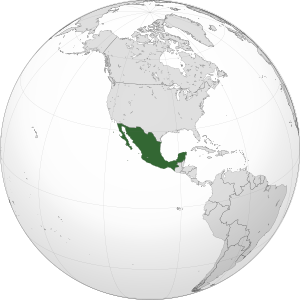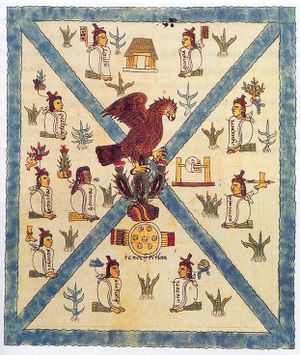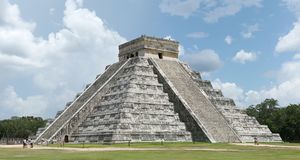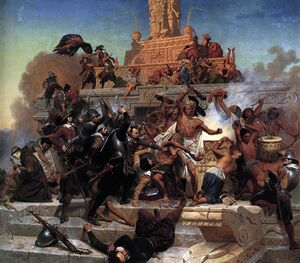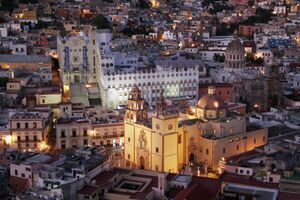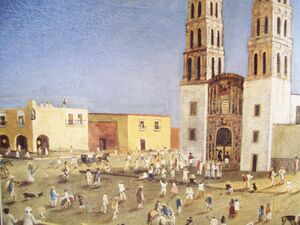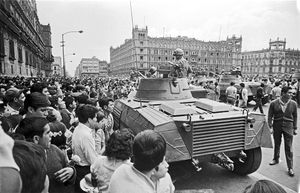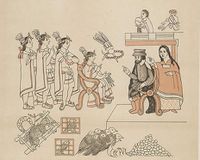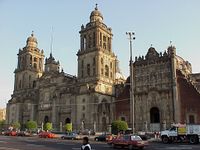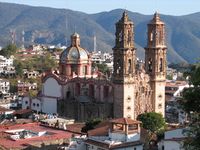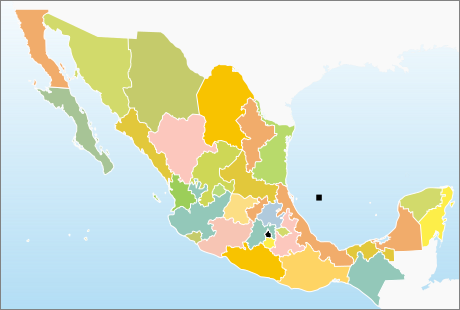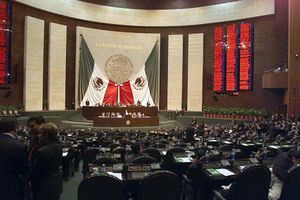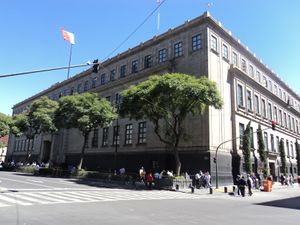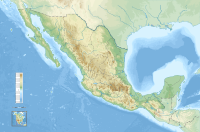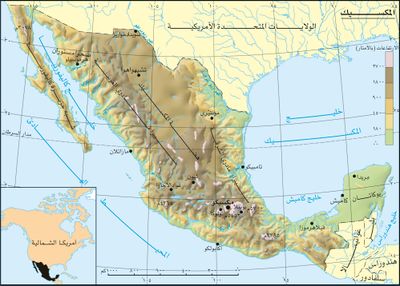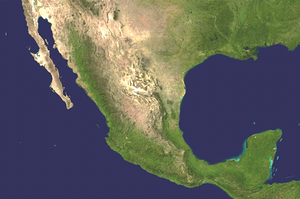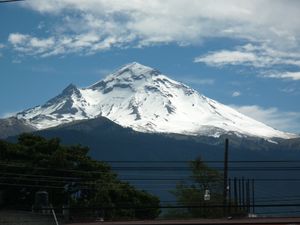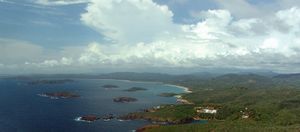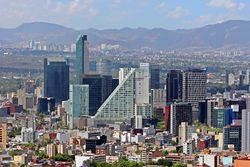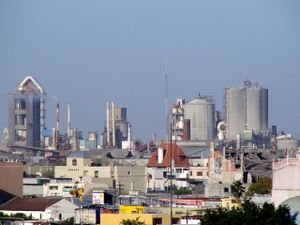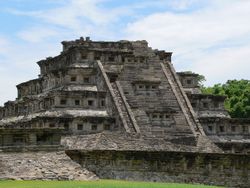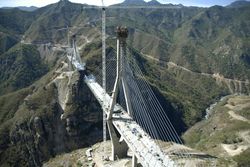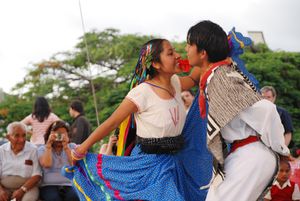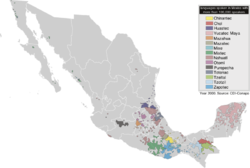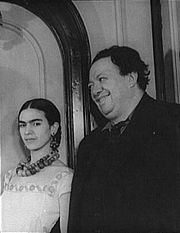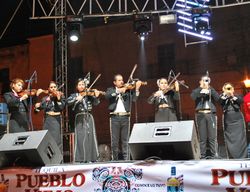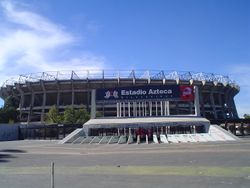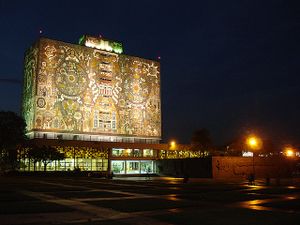المكسيك
United Mexican States Estados Unidos Mexicanos (Spanish) | |
|---|---|
| العاصمة و أكبر مدينة | Mexico City 19°26′N 99°8′W / 19.433°N 99.133°W |
| اللغات الرسمية | Spanish (de facto) |
| Co-official languages | |
| الجماعات العرقية | See below |
| الدين (2023)[1] |
|
| صفة المواطن | Mexican |
| الحكومة | Federal presidential republic[2] |
| Andrés Manuel López Obrador | |
| Ana Lilia Rivera | |
| Marcela Guerra Castillo | |
| Norma Lucía Piña Hernández | |
| التشريع | Congress |
| Senate | |
| Chamber of Deputies | |
| Independence from Spain | |
| 16 September 1810 | |
• Declared | 27 September 1821 |
| 28 December 1836 | |
| 4 October 1824 | |
| 5 February 1857 | |
| 5 February 1917 | |
| المساحة | |
• الإجمالية | 1،972،550 km2 (761،610 sq mi) (13th) |
• الماء (%) | 1.58 (as of 2015)[3] |
| التعداد | |
• تقدير 2023 | |
• الكثافة | 61/km2 (158.0/sq mi) (142nd) |
| ن.م.إ. (ق.ش.م.) | تقدير 2023 |
• الإجمالي | ▲ $3.277 trillion[5] (12th) |
• للفرد | ▲ $24,975[5] (70th) |
| ن.م.إ. (الإسمي) | تقدير 2023 |
• الإجمالي | ▲ $1.811 trillion[5] (12th) |
• للفرد | ▲ $13,803[5] (63rd) |
| جيني (2018) | ▼ 41.8[6] medium |
| م.ت.ب. (2021) | ▲ 0.758[7] high · 86th |
| العملة | Mexican peso (MXN) |
| التوقيت | UTC−8 to −5 (See Time in Mexico) |
• الصيفي (التوقيت الصيفي) | UTC−7 to −5 (varies) |
| صيغة التاريخ | dd/mm/yyyy |
| جانب السواقة | right |
| مفتاح الهاتف | +52 |
| النطاق العلوي للإنترنت | .mx |
المكسيك (Mexico، /ˈmɛks[invalid input: 'ɨ']koʊ/ (![]() استمع); إسپانية: México النطق الإسپاني: [ˈmexiko])، ورسمياً الولايات المتحدة المكسيكية (الإسپانية: Estados Unidos Mexicanos ),[10][11][12][13]، هي جمهورية اتحادية في أمريكا الشمالية. تحدها من الشمال الولايات المتحدة؛ من الجنوب والغرب المحيط الهادي؛ من الجنوب الشرقي گواتيمالا؛ بليز، والبحر الكاريبي؛ ومن الشرق خليج المكسيك.[14]تبلغ مساحتها 2 مليون كيلو متر مربع،[13] المكسيك هي خامس أكبر بلدان الأمريكتين من حيث إجمالي المساحة والثالثة عشر في العالم. يقدر عدد سكانها بأكثر من 114 مليون نسمة،[15] وهي الحادية عشر في العالم وأكثر البلدان الناطقة بالإسپانية اكتظاظاً بالسكان في العالم وثاني أكثر البلدان إكتظاظاً بالسكان في أمريكا اللاتينية. المكسيك عبارة عن اتحاد يتكون من 31 ولاية ومقاطعة فدرالية، المدينة العاصمة.
استمع); إسپانية: México النطق الإسپاني: [ˈmexiko])، ورسمياً الولايات المتحدة المكسيكية (الإسپانية: Estados Unidos Mexicanos ),[10][11][12][13]، هي جمهورية اتحادية في أمريكا الشمالية. تحدها من الشمال الولايات المتحدة؛ من الجنوب والغرب المحيط الهادي؛ من الجنوب الشرقي گواتيمالا؛ بليز، والبحر الكاريبي؛ ومن الشرق خليج المكسيك.[14]تبلغ مساحتها 2 مليون كيلو متر مربع،[13] المكسيك هي خامس أكبر بلدان الأمريكتين من حيث إجمالي المساحة والثالثة عشر في العالم. يقدر عدد سكانها بأكثر من 114 مليون نسمة،[15] وهي الحادية عشر في العالم وأكثر البلدان الناطقة بالإسپانية اكتظاظاً بالسكان في العالم وثاني أكثر البلدان إكتظاظاً بالسكان في أمريكا اللاتينية. المكسيك عبارة عن اتحاد يتكون من 31 ولاية ومقاطعة فدرالية، المدينة العاصمة.
والمكسيك هي إحدى أكبر الاقتصادات في العالم، وعاشر أكبر منتج للنفط في العالم، وأكبر منتج للفضة في العالم وتعتبر قوة اقليمية وقوة متوسطة.[16][17][18][19] بالإضافة إلى ذلك، فقد كانت المكسيك أول عضو أمريكي لاتيني في منظمة التعاون الاقتصادي والتنمية (منذ 1994)، وتعتبر ذات دخل أعلى من المتوسط من قبل البنك الدولي.[20] تعتبر المكسيك بلد صناعي حديث[21][22][23][24] قوى ناشئة.[25] ولديها خامس أكبر ن.م.إ. اسمي وعاشر أكبر ن.م.إ. من حيث صافي القوة الشرائية. اقتصادها يرتبط بقوة بشركائها في اتفاقية التجارة الحرة في أمريكا الشمالية، خاصة الولايات المتحدة الأمريكية.[26][27] المكسيك تحتل الترتيب السادس في العالم والأول في الأمريكتين من حيث عدد مواقع التراث العالمي حيث تضم 32 موقع،[28][29][30] وفي 2010 كانت تاسع أكثر المدن زيارة في العالم حيث تستقبل 22.5 مليون سائح دولي سنوياً.[31] حسب گولدمان ساكس، بحلول 2050 من المتوقع أن تصبح المكسيك خامس أكبر اقتصاد في العالم.[32] حسب تقديرات پرايسواترهاوسكوپرز في يناير 2013، بحلول 2050 ستصبح المكسيك سابع أكبر اقتصاد في العالم.[33] المكسيك عضو في مؤسسات بارزة مثل الأمم المتحدة، منظمة التجارة العالمية، مجموعة العشرين ومتحدون من أجل التوافق.
Human presence in Pre-Columbian Mexico goes back to 8,000 BCE. It became one of the world's six cradles of civilization. The Mesoamerican region was home to many intertwined civilizations, including the Olmec, Maya, Zapotec, Teotihuacan, and Purepecha. The Aztecs dominated the region in the century before European contact. In 1521, the Spanish Empire and its indigenous allies conquered the Aztec Empire from its capital Tenochtitlan (now Mexico City), establishing the colony of New Spain.[34] Over the next three centuries, Spain and the Catholic Church expanded the territory, enforced Christianity and spread the Spanish language.[35] With the discovery of rich deposits of silver in Zacatecas and Guanajuato, New Spain became one of the most important mining centers worldwide. The colonial order came to an end in the early nineteenth century with the Mexican War of Independence.
Mexico's early history as an independent nation state was marked by political and socioeconomic upheaval, both domestically and in foreign affairs. The United States invaded as a consequence of the Texas Revolt by American settlers, which led to the Mexican–American War and huge territorial losses in 1848.[36] After the introduction of liberal reforms in the Constitution of 1857, conservatives reacted with the War of Reform and prompted France to invade the country and install an Empire, against the Republican resistance led by liberal President Benito Juárez, which emerged victorious. The last decades of the 19th century were dominated by the dictatorship of Porfirio Díaz, who sought to modernize Mexico and restore order.[37] However, the Porfiriato era led to great social unrest and ended with the outbreak in 1910 of the decade-long Mexican Revolution (civil war). This conflict led to profound changes, including the proclamation of the 1917 Constitution, which remains in effect to this day. The remaining war generals ruled as a succession of presidents until the Institutional Revolutionary Party (PRI) emerged in 1929.
The PRI governed Mexico for the next 70 years, first under a set of paternalistic developmental policies of considerable economic success. During World War II Mexico also played an important role for the Allied war effort.[38][39] Nonetheless, the PRI regime resorted to repression and electoral fraud to maintain power, and moved the country to a more US-aligned neoliberal economic policy during the late 20th century. This culminated with the signing of the North American Free Trade Agreement in 1994, which caused a major indigenous rebellion in the state of Chiapas. PRI lost the presidency for the first time in 2000, against the conservative party (PAN).
Mexico has the world's 15th-largest economy by nominal GDP and the 11th-largest by PPP, with the United States being its largest economic partner. As a newly industrialized[40] and developing country ranking 86th, high in the Human Development Index, its large economy and population, cultural influence, and steady democratization make Mexico a regional and middle power[41][42][43] which is also identified as an emerging power by several analysts.[44][45][46][47] Mexico ranks first in the Americas and seventh in the world for the number of UNESCO World Heritage Sites.[48] It is also one of the world's 17 megadiverse countries, ranking fifth in natural biodiversity.[49] Mexico's rich cultural and biological heritage, as well as varied climate and geography, makes it a major tourist destination: as of 2018, it was the sixth most-visited country in the world, with 39 million international arrivals.[50] However, the country continues to struggle with social inequality, poverty and extensive crime. It ranks poorly on the Global Peace Index,[51] due in large part to ongoing conflict between drug trafficking syndicates. This "drug war" has led to over 120,000 deaths since 2006.[52] Mexico is a member of United Nations, the G20, the Organisation for Economic Co-operation and Development (OECD), the World Trade Organization (WTO), the Asia-Pacific Economic Cooperation forum, the Organization of American States, Community of Latin American and Caribbean States, and the Organization of Ibero-American States.
التسمية
بعد حصول إسپانيا الجديدة على الاستقلال عن إسپانيا، تقرر أن يسمى البلد الجديد باسم العاصمة مكسيكو سيتي، والتي تأسست في 1524 على أنقاض عاصمة الأزتك القديمة تينوختيتلان. ويأتي الاسم من لغة الناهوا، ومعناها ليس معروفا. وقد قيل أنه مشتق من مكسيتلي أو مكسيهتلي، وهو الاسم السري لإله الحرب وراعي الأزتك، هويتزل، وفي هذه الحالة فإن مكسيكو تعني "المكان حيث يعيش مكسيتلي".
فرضية أخرى تشير إلى أن مكسيكو كلمة مشتقة من متزتلي ("القمر")، كسيكتلي ("الوسط" أو "الابن")، واللاحقة كو تعني (مكان)، وفي هذه الحالة فإنها تعني "مكان في مركز القمر" أو "مكان في وسط بحيرة القمر"، في إشارة إلى بحيرة تيكسكوكو.نظام البحيرات المترابطة، والتي كانت تيكسكوكو في مركزها، كان على شكل أرنب، وهي نفس الصورة التي رآها الازتك علي القمر. تينوختيتلان كانت تقع في وسط (أو سرة) البحيرة (أو الأرانب / القمر).ولا تزال هناك فرضية أخرى تشير إلى أنه مشتق من مكتيلي، إلهة الصبار الأمريكي.
اسم المدينة ترجم إلى الاسبانية بلفظ مكسيكو (Mexico) بالقيمة الصوتية للـ x في اللغة الاسبانية في العصور الوسطى، والتي تمثل اللثوِية الغارِية أو الشجرية الاحتكاكية التي لا صوت لها /ʃ/ هذا النطق، بالإضافة إلى الشجرية الاحتكاكية ذات الصوت /ʒ/، التي يمثلها حرف جيه، تطورت لتصبح حلقية احتكاكية لا صوت لها /x/ خلال القرن السادس وأدى هذا إلى استخدام اسم ميخيكو Méjico المتغير في العديد من المنشورات باللغة الاسبانية، وعلى الأخص في اسبانيا، في حين أنه في المكسيك وغيرها من معظم البلدان الناطقة بالإسبانية كان المكسيك هو الاسم المفضل. في السنوات الأخيرة الأكاديمية الملكية الإسبانية، التي تنظم اللغة الإسبانية، قررت أن كلا الخيارين مقبول بالاسبانية وأنه بالرغم من ذلك، فإن الإملاء المفضل هو México. غالبية المنشورات في جميع البلدان الناطقة بالإسبانية تتمسك بالقاعدة الجديدة، على الرغم من أن الخيار البديل ما زال يستخدم في بعض الأحيان. في اللغة الإنگليزية، حرف اكس أو x في المكسيك لا يمثل الصوت الأصلي ولا الصوت الحالي، ولكن يمثل حرف الاكس الانجليزي. و قد تغير اسم البلد الرسمي بتغير شكل الحكومة. في مناسبتين (1821-1823 و 1863-1867)، كانت البلد تعرف باسم الإمبراطورية المكسيكية. جميع الدساتير الثلاثة الاتحادية (1824، 1857 و1917 الدستور الحالي) استخدمت اسم استادوس يونيدوس مكسيكانوس
التاريخ
Indigenous civilizations before European contact (pre-1519)
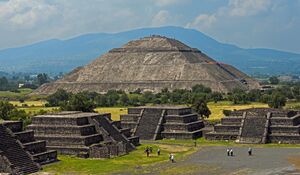
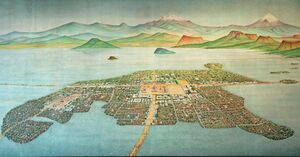
The earliest human artifacts in Mexico are chips of stone tools found near campfire remains in the Valley of Mexico and radiocarbon-dated to circa 10,000 years ago.[53] Mexico is the site of the domestication of maize, tomato, and beans, which produced an agricultural surplus. This enabled the transition from paleo-Indian hunter-gatherers to sedentary agricultural villages beginning around 5000 BCE.[54] In the subsequent formative eras, maize cultivation and cultural traits such as a mythological and religious complex, and a vigesimal (base 20) numeric system, were diffused from the Mexican cultures to the rest of the Mesoamerican culture area.[55] In this period, villages became more dense in terms of population, becoming socially stratified with an artisan class, and developing into chiefdoms. The most powerful rulers had religious and political power, organizing the construction of large ceremonial centers.[56]
The earliest complex civilization in Mexico was the Olmec culture, which flourished on the Gulf Coast from around 1500 BCE. Olmec cultural traits diffused through Mexico into other formative-era cultures in Chiapas, Oaxaca and the Valley of Mexico. The formative period saw the spread of distinct religious and symbolic traditions, as well as artistic and architectural complexes.[57] The formative-era of Mesoamerica is considered one of the six independent cradles of civilization. In the subsequent pre-classical period, the Maya and Zapotec civilizations developed complex centers at Calakmul and Monte Albán, respectively. During this period the first true Mesoamerican writing systems were developed in the Epi-Olmec and Zapotec cultures. The Mesoamerican writing tradition reached its height in the Classic Maya Hieroglyphic script. The earliest written histories date from this era. The tradition of writing was important after the Spanish conquest in 1521, with indigenous scribes learning to write their languages in alphabetic letters, while also continuing to create pictorial texts.[58][59]
In Central Mexico, the height of the classic period saw the ascendancy of Teotihuacán, which formed a military and commercial empire. Teotihuacan, with a population of more than 150,000 people, had some of the largest pyramidal structures in the pre-Columbian Americas.[60] After the collapse of Teotihuacán around 600 AD, competition ensued between several important political centers in central Mexico such as Xochicalco and Cholula. At this time, during the Epi-Classic, Nahua peoples began moving south into Mesoamerica from the North, and became politically and culturally dominant in central Mexico, as they displaced speakers of Oto-Manguean languages. During the early post-classic era (ca. 1000–1519 CE), Central Mexico was dominated by the Toltec culture, Oaxaca by the Mixtec, and the lowland Maya area had important centers at Chichén Itzá and Mayapán. Toward the end of the post-Classic period, the Mexica established dominance, establishing a political and economic empire based in the city of Tenochtitlan (modern Mexico City), extending from central Mexico to the border with Guatemala.[61] Alexander von Humboldt popularized the modern usage of "Aztec" as a collective term applied to all the people linked by trade, custom, religion, and language to the Mexica state and Ēxcān Tlahtōlōyān, the Triple Alliance.[62] In 1843, with the publication of the work of William H. Prescott, it was adopted by most of the world. This usage has been the subject of debate since the late 20th century.[63]
Spanish conquest and colonial era (1519–1821)
Although the Spanish Empire had established colonies in the Caribbean starting in 1493, only in the second decade of the sixteenth century did they begin exploring the east coast of Mexico. The Spanish first learned of Mexico during the Juan de Grijalva expedition of 1518. The Spanish conquest of the Aztec Empire began in February 1519 when Hernán Cortés founded the Spanish city of Veracruz. The 1521 capture of Tenochtitlan and immediate founding of the Spanish capital Mexico City on its ruins was the beginning of a 300-year-long colonial era during which Mexico was known as Nueva España (New Spain). Two factors made Mexico a jewel in the Spanish Empire: the existence of large, hierarchically organized Mesoamerican populations that rendered tribute and performed obligatory labor and the discovery of vast silver deposits in northern Mexico.[64]
The Kingdom of New Spain was created from the remnants of the Aztec empire. The two pillars of Spanish rule were the State and the Roman Catholic Church, both under the authority of the Spanish crown. In 1493 the pope had granted sweeping powers to the Spanish monarchy for its overseas empire, with the proviso that the crown spread Christianity in its new realms. In 1524, King Charles I created the Council of the Indies based in Spain to oversee State power in its overseas territories; in New Spain the crown established a high court in Mexico City, the Real Audiencia, and then in 1535 created the Viceroyalty of New Spain. The viceroy was highest official of the State. In the religious sphere, the diocese of Mexico was created in 1530 and elevated to the Archdiocese of Mexico in 1546, with the archbishop as the head of the ecclesiastical hierarchy. Castilian Spanish was the language of rulers. The Catholic faith was the only one permitted, with non-Catholics and Catholics (excluding Indians) holding unorthodox views being subject to the Mexican Inquisition, established in 1571.[65]
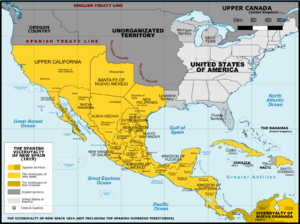
Spanish military forces, sometimes accompanied by native allies, led expeditions to conquer territory or quell rebellions through the colonial era. Notable Amerindian revolts in sporadically populated northern New Spain include the Chichimeca War (1576–1606),[66] Tepehuán Revolt (1616–1620),[67] and the Pueblo Revolt (1680), the Tzeltal Rebellion of 1712 was a regional Maya revolt.[68] Most rebellions were small-scale and local, posing no major threat to the ruling elites.[69] To protect Mexico from the attacks of English, French, and Dutch pirates and protect the Crown's monopoly of revenue, only two ports were open to foreign trade—Veracruz on the Atlantic (Connecting to Spain) and Acapulco on the Pacific (Connecting to the Philippines). Among the best-known pirate attacks are the 1663 Sack of Campeche[70] and 1683 Attack on Veracruz.[71] Of greater concern to the crown was of foreign invasion, especially after Britain seized in 1762 the Spanish ports of Havana, Cuba and Manila in the Seven Years' War. It created a standing military, increased coastal fortifications, and expanded the northern presidios and missions into Alta California. The volatility of the urban poor in Mexico City was evident in the 1692 riot in the Zócalo. The riot over the price of maize escalated to a full-scale attack on the seats of power, with the viceregal palace and the archbishop's residence attacked by the mob.[72]
Independence era (1808–1855)
The upheaval in the Spanish Empire that resulted in the independence of most of its New World territories was due to Napoleon Bonaparte's invasion of Spain in 1808. In Mexico, elites argued that sovereignty now reverted to "the people" and that town councils (cabildos) were the most representative bodies.[73] On 16 September 1810, secular priest Miguel Hidalgo y Costilla declared against "bad government" in the small town of Dolores, Guanajuato. This event, known as the Cry of Dolores (Spanish: Grito de Dolores) is commemorated each year, on 16 September, as Mexico's independence day.[74] Hidalgo and some of his soldiers were eventually captured, Hidalgo was defrocked, and they were executed by firing squad on 31 July 1811.
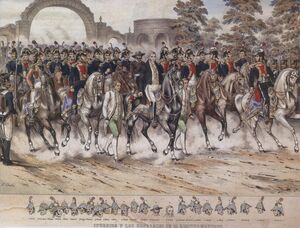
The first 35 years after Mexico's independence were marked by political instability and the changing of the Mexican state from a transient monarchy to a fragile federated republic.[75] There were military coups d'état, foreign invasions, ideological conflict between Conservatives and Liberals, and economic stagnation. Catholicism remained the only permitted religious faith and the Catholic Church as an institution retained its special privileges, prestige, and property, a bulwark of Conservatism. The army, another Conservative-dominated institution, also retained its privileges. Former Royal Army General Agustín de Iturbide became regent, as newly independent Mexico sought a constitutional monarch from Europe. When no member of a European royal house desired the position, Iturbide himself was declared Emperor Agustín I. The young and weak United States was the first country to recognize Mexico's independence, sending an ambassador to the court and sending a message to Europe via the Monroe Doctrine not to intervene in Mexico. The emperor's rule was short (1822–1823) and he was overthrown by army officers in the Plan of Casa Mata.[76]
After the forced abdication of the monarch, Central America and Chiapas left the union to form the Federal Republic of Central America. In 1824, a constitution of a federated republic was promulgated and the First Mexican Republic was established. Former insurgent General Guadalupe Victoria became the first president of the republic — the first of many army generals to hold the presidency.
In 1829, former insurgent general and fierce Liberal Vicente Guerrero, a signatory of the Plan of Iguala that achieved independence, became president in a disputed election. During his short term in office, April to December 1829, he abolished slavery. As a visibly mixed-race man of modest origins, Guerrero was seen by white political elites as an interloper.[77] His Conservative vice president, former Royalist General Anastasio Bustamante, led a coup against him and Guerrero was judicially murdered.[78] There was constant strife between the Liberals (also known as Federalists), who were supporters of a federal form of decentralized government, and their political rivals, the Conservatives (also known as Centralists), who proposed a hierarchical form of government.
Mexico's ability to maintain its independence and establish a viable government was in question. Spain attempted to reconquer its former colony during the 1820s, but eventually recognized its independence. France attempted to recoup losses it claimed for its citizens during Mexico's unrest and blockaded the Gulf Coast during the so-called Pastry War of 1838–1839.[79] General Antonio López de Santa Anna emerged as a national hero because of his role in both these conflicts; Santa Anna came to dominate the politics for the next 25 years, often known as the "Age of Santa Anna", until his own overthrow in 1855.[80]
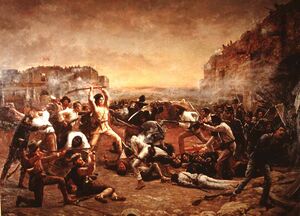
Mexico also contended with indigenous groups which controlled territory that Mexico claimed in the north. For example, the Comanche controlled a huge territory in sparsely populated central and northern Texas.[81] Wanting to stabilize and develop that area — and as few people from central Mexico had chosen to resettle to this remote and hostile territory — the Mexican government encouraged Anglo-American immigration into present-day Texas, a region that bordered that United States. Mexico by law was a Catholic country; the Anglo-Americans were primarily Protestant English speakers from the southern United States. Some brought their black slaves, which after 1829 was contrary to Mexican law. In 1835, Santa Anna sought to centralize government rule in Mexico, suspending the 1824 constitution and promulgating the Seven Laws, which placed power in his hands. As a result, civil war spread across the country. Three new governments declared independence: the Republic of Texas, the Republic of the Rio Grande and the Republic of Yucatán.[82] The largest blow to Mexico was the U.S. invasion of Mexico in 1846 in the Mexican–American War. Mexico lost much of its sparsely populated northern territory, sealed in the 1848 Treaty of Guadalupe Hidalgo. Despite that disastrous loss, Santa Anna returned to the presidency yet again before being ousted and exiled in the Liberal Revolution of Ayutla.
Liberal era (1855–1911)
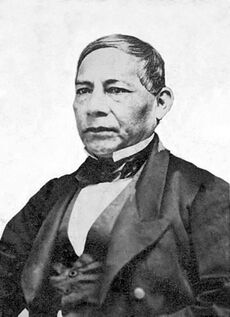
The overthrow of Santa Anna and the establishment of a civilian government by Liberals allowed them to enact laws that they considered vital for Mexico's economic development. The Liberal Reform attempted to modernize Mexico's economy and institutions along liberal principles. They promulgated a new Constitution of 1857, separating Church and State, stripping the Church and the military of their special privileges (fueros); mandating the sale of Church-owned property and sale of indigenous community lands, and secularizing education.[83] Conservatives revolted, touching off civil war between rival Liberal and Conservative governments (1858–1861).
The Liberals defeated the Conservative army on the battlefield, but Conservatives sought another solution to gain power via foreign intervention by the French. Mexican conservatives asked Emperor Napoleon III to place a European monarch as head of state in Mexico. The French Army defeated the Mexican Army and placed Maximilian Hapsburg on the newly established throne of Mexico, supported by Mexican Conservatives and propped up by the French Army. The Liberal republic under Benito Juárez was basically a government in internal exile, but with the end of the Civil War in the U.S. in April 1865, that government began aiding the Mexican Republic. Two years later, the French Army withdrew its support, but Maximilian remained in Mexico. Republican forces captured him and he was executed. The "Restored Republic" saw the return of Juárez, "the personification of the embattled republic,"[84] as president.
The Conservatives had been not only defeated militarily, but also discredited politically for their collaboration with the French invaders. Liberalism became synonymous with patriotism.[85] The Mexican Army that had its roots in the colonial royal army and then the army of the early republic was destroyed. New military leaders had emerged from the War of the Reform and the conflict with the French, most notably Porfirio Díaz, a hero of the Cinco de Mayo, who now sought civilian power. Juárez won re-election in 1867, but was challenged by Díaz. Díaz then rebelled, crushed by Juárez. Having won re-election, Juárez died in office in July 1872, and Liberal Sebastián Lerdo de Tejada became president, declaring a "religion of state" for rule of law, peace, and order. When Lerdo ran for re-election, Díaz rebelled against the civilian president, issuing the Plan of Tuxtepec. Díaz had more support and waged guerrilla warfare against Lerdo. On the verge of Díaz's victory on the battlefield, Lerdo fled from office into exile.[86]
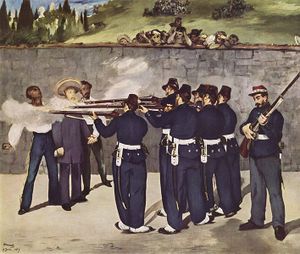
After the turmoil in Mexico from 1810 to 1876, the 35-year rule of Liberal General Porfirio Díaz (r.1876–1911) allowed Mexico to rapidly modernize in a period characterized as one of "order and progress". The Porfiriato was characterized by economic stability and growth, significant foreign investment and influence, an expansion of the railroad network and telecommunications, and investments in the arts and sciences.[87]
Díaz ruled with a group of advisors that became known as the científicos ("scientists").[88] The most influential científico was Secretary of Finance José Yves Limantour.[89] The Porfirian regime was influenced by positivism.[90] They rejected theology and idealism in favor of scientific methods being applied towards national development. An integral aspect of the liberal project was secular education. The Díaz government led a protracted conflict against the Yaqui that culminated with the forced relocation of thousands of Yaqui to Yucatán and Oaxaca. As the centennial of independence approached, Díaz gave an interview where he said he was not going to run in the 1910 elections, when he would be 80. Political opposition had been suppressed and there were few avenues for a new generation of leaders. But his announcement set off a frenzy of political activity, including the unlikely candidacy of the scion of a rich landowning family, Francisco I. Madero. Madero won a surprising amount of political support when Díaz changed his mind and ran in the election, jailing Madero. The September centennial celebration of independence was the last celebration of the Porfiriato. The Mexican Revolution starting in 1910 saw a decade of civil war, the "wind that swept Mexico."[91]
Mexican Revolution (1910–1920)
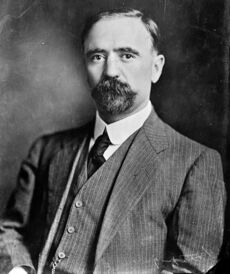
The Mexican Revolution was a decade-long transformational conflict.[92] It began with scattered uprisings against President Díaz after the fraudulent 1910 election, his resignation in May 1911, demobilization of rebel forces and an interim presidency of a member of the old guard, and the democratic election of a rich, civilian landowner, Francisco I. Madero in fall 1911. In February 1913, a military coup d'état overthrew Madero's government, with the support of the U.S., resulting in Madero's murder by agents of Federal Army General Victoriano Huerta. A coalition of anti-Huerta forces in the North, the Constitutional Army led by Governor of Coahuila Venustiano Carranza, and a peasant army in the South under Emiliano Zapata defeated the Federal Army.[93]
In 1914, that army was dissolved as an institution, leaving only revolutionary forces. Following the revolutionaries' victory against Huerta, they sought to broker a peaceful political solution, but the coalition splintered, plunging Mexico again into a civil war. Constitutionalist general Pancho Villa, commander of the Division of the North, broke with Carranza and allied with Zapata. Carranza's best general Alvaro Obregón defeated Villa, his former comrade-in-arms in the Battle of Celaya in 1915, and Villa's northern forces melted away. Zapata's forces in the south reverted to guerrilla warfare. Carranza became the de facto head of Mexico, and the U.S. recognized his government.[93]
In 1916, the winners met at a constitutional convention to draft the Constitution of 1917, which was ratified in February 1917. The Constitution empowered the government to expropriate resources including land, gave rights to labor, and strengthened anticlerical provisions of the 1857 Constitution.[93] With amendments, it remains the governing document of Mexico. It is estimated that the war killed 900,000 of the 1910 population of 15 million.[94][95] Although often viewed as an internal conflict, the revolution had significant international elements.[96] During the Revolution, the U.S. Republican administration of Taft supported the Huerta coup against Madero, but when Democrat Woodrow Wilson was inaugurated as president in March 1913, Wilson refused to recognize Huerta's regime and allowed arms sales to the Constitutionalists. Wilson ordered troops to occupy the strategic port of Veracruz in 1914, which was lifted.[97]
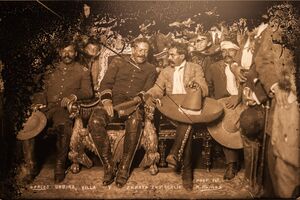
After Pancho Villa was defeated by revolutionary forces in 1915, he led an incursion raid into Columbus, New Mexico, prompting the U.S. to send 10,000 troops led by General John J. Pershing in an unsuccessful attempt to capture Villa. Carranza pushed back against U.S. troops being in northern Mexico. The expeditionary forces withdrew as the U.S. entered World War I.[98] Germany attempted to get Mexico to side with it, sending a coded telegram in 1917 to incite war between the U.S. and Mexico, with Mexico to regain the territory it lost in the Mexican-American War.[99] Mexico remained neutral in the conflict.
Consolidating power, President Carranza had peasant-leader Emiliano Zapata assassinated in 1919. Carranza had gained support of the peasantry during the Revolution, but once in power he did little to institute land reform, which had motivated many to fight in the Revolution. Carranza in fact returned some confiscated land to their original owners. President Carranza's best general, Obregón, served briefly in his administration, but returned to his home state of Sonora to position himself to run in the 1920 presidential election. Since Carranza could not run for re-election, he chose a civilian, political and revolutionary no-body to succeed him, intending to remain the power behind the presidency. Obregón and two other Sonoran revolutionary generals drew up the Plan of Agua Prieta, overthrowing Carranza, who died fleeing Mexico City in 1920. General Adolfo de la Huerta became interim president, followed by the election of General Álvaro Obregón.
Political consolidation and one-party rule (1920–2000)

The first quarter-century of the post-revolutionary period (1920–1946) was characterized by revolutionary generals serving as Presidents of Mexico, including Álvaro Obregón (1920–24), Plutarco Elías Calles (1924–28), Lázaro Cárdenas (1934–40), and Manuel Avila Camacho (1940–46). The post-revolutionary project of the Mexican government sought to bring order to the country, end military intervention in politics, and create organizations of interest groups. Workers, peasants, urban office workers, and even the army for a short period were incorporated as sectors of the single party that dominated Mexican politics from its founding in 1929. Obregón instigated land reform and strengthened the power of organized labor. He gained recognition from the United States and took steps to settle claims with companies and individuals that lost property during the Revolution. He imposed his fellow former Sonoran revolutionary general, Calles, as his successor, prompting an unsuccessful military revolt. As president, Calles provoked a major conflict with the Catholic Church and Catholic guerrilla armies when he strictly enforced anticlerical articles of the 1917 Constitution. The Church-State conflict was mediated and ended with the aid of the U.S. Ambassador to Mexico and ended with an agreement between the parties in conflict. Although the constitution prohibited reelection of the president, Obregón wished to run again and the constitution was amended to allow non-consecutive re-election. Obregón won the 1928 elections, but was assassinated by a Catholic zealot, causing a political crisis of succession. Calles could not become president again, since he had just ended his term. He sought to set up a structure to manage presidential succession, founding the party that was to dominate Mexico until the late twentieth century. Calles declared that the Revolution had moved from caudillismo (rule by strongmen) to the era institucional (institutional era).[100]
Despite not holding the presidency, Calles remained the key political figure during the period known as the Maximato (1929–1934). The Maximato ended during the presidency of Lázaro Cárdenas, who expelled Calles from the country and implemented many economic and social reforms. This included the Mexican oil expropriation in March 1938, which nationalized the U.S. and Anglo-Dutch oil company known as the Mexican Eagle Petroleum Company. This movement would result in the creation of the state-owned Mexican oil company Pemex. This sparked a diplomatic crisis with the countries whose citizens had lost businesses by Cárdenas's radical measure, but since then the company has played an important role in the economic development of Mexico. Cárdenas's successor, Manuel Ávila Camacho (1940–1946) was more moderate, and relations between the U.S. and Mexico vastly improved during World War II, when Mexico was a significant ally, providing manpower and materiel to aid the war effort. From 1946 the election of Miguel Alemán, the first civilian president in the post-revolutionary period, Mexico embarked on an aggressive program of economic development, known as the Mexican miracle, which was characterized by industrialization, urbanization, and the increase of inequality in Mexico between urban and rural areas.[101]
With robust economic growth, Mexico sought to showcase it to the world by hosting the 1968 Summer Olympics. The government poured huge resources into building new facilities, prompting political unrest by university students and others. Demonstrations in central Mexico City went on for weeks before the planned opening of the games, with the government of Gustavo Díaz Ordaz cracking down. The culmination was the Tlatelolco Massacre,[102] which killed around 300 protesters based on conservative estimates and perhaps as many as 800.[103] Although the economy continued to flourish for some, social inequality remained a factor of discontent. PRI rule became increasingly authoritarian and at times oppressive in what is now referred to as the Mexican Dirty War.[104]
Luis Echeverría was elected president in 1970. His government had to contend with mistrust of Mexicans and increasing economic problems. He instituted electoral reforms.[105][106]
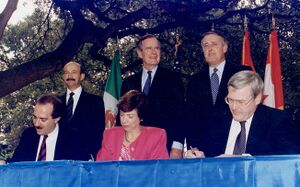
In the 1980s the first cracks emerged in the PRI's complete political dominance. In Baja California, the PAN candidate was elected as governor. When De la Madrid chose Carlos Salinas de Gortari as the candidate for the PRI, and therefore a foregone presidential victor, Cuauhtémoc Cárdenas, son of former President Lázaro Cárdenas, broke with the PRI and challenged Salinas in the 1988 elections. In 1988 there was massive electoral fraud, with results showing that Salinas had won the election by the narrowest percentage ever. There were massive protests in Mexico City to the stolen election. Salinas took the oath of office on 1 December 1988.[107] In 1990 the PRI was famously described by Mario Vargas Llosa as the "perfect dictatorship", but by then there had been major challenges to the PRI's hegemony.[108][109][110]
Salinas embarked on a program of neoliberal reforms that fixed the exchange rate of the peso, controlled inflation, opened Mexico to foreign investment, and began talks with the U.S. and Canada to join their free-trade agreement. In order to do that, the Constitution of 1917 was amended in several important ways. Article 27, which had allowed the government to expropriate natural resources and distribute land, was amended to end agrarian reform and to guarantee private owners' property rights. The anti-clerical articles that muzzled religious institutions, especially the Catholic Church, were amended and Mexico reestablished diplomatic relations with the Holy See. Signing on to the North American Free Trade Agreement (NAFTA) removed Mexico's autonomy over trade policy. The agreement came into effect on 1 January 1994; the same day, the Zapatista Army of National Liberation (EZLN) in Chiapas began armed peasant rebellion against the federal government, which captured a few towns, but brought world attention to the situation in Mexico. The armed conflict was short-lived and has continued as a non-violent opposition movement against neoliberalism and globalization. In 1994, following the assassination of the PRI's presidential candidate Luis Donaldo Colosio, Salinas was succeeded by victorious PRI candidate Ernesto Zedillo. Salinas left Zedillo's government to deal with the Mexican peso crisis, requiring a $50 billion IMF bailout. Major macroeconomic reforms were started by Zedillo, and the economy rapidly recovered and growth peaked at almost 7% by the end of 1999.[111]
Contemporary Mexico
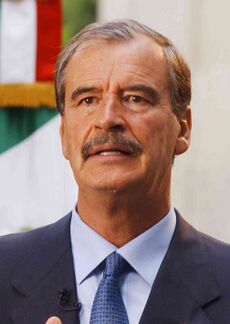
In 2000, after 71 years, the PRI lost a presidential election to Vicente Fox of the opposition conservative National Action Party (PAN). In the 2006 presidential election, Felipe Calderón from the PAN was declared the winner, with a very narrow margin (0.58%) over leftist politician Andrés Manuel López Obrador of the Party of the Democratic Revolution (PRD).[112] López Obrador, however, contested the election and pledged to create an "alternative government".[113]
After twelve years, in 2012, the PRI won the presidency again with the election of Enrique Peña Nieto. However, he won with a plurality of about 38%, and did not have a legislative majority.[114]
After founding the new political party MORENA, Andrés Manuel López Obrador won the 2018 presidential election with over 50% of the vote. His political coalition, led by his left-wing party founded after the 2012 elections, included parties and politicians from all over the political spectrum. The coalition also won a majority in both the upper and lower congress chambers. His success is attributed to the country's other strong political alternatives exhausting their chances as well as the politician adopting a moderate discourse with a focus on conciliation.[115]
Mexico has contended with high crime rates, official corruption, narcotrafficking, and a stagnant economy. Many state-owned industrial enterprises were privatized starting in the 1990s, with neoliberal reforms, but Pemex, the state-owned petroleum company is only slowly being privatized, with exploration licenses being issued.[116] In a push against government corruption, the ex-CEO of Pemex has been arrested.[117]
Although there were fears of electoral fraud in Mexico's 2018 presidential elections,[118] the results gave a mandate to AMLO.[119] Andrés Manuel López Obrador won a landslide victory in the July 2018 presidential elections and became the first leftwing president for decades.[120]
الغزو (1519)
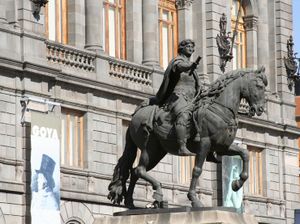
تتالت بعثات الاستكشاف الإسبانية. وفي عام 1519 استولى الحاكم الإسباني على الحكم وعزل الملك موكتزوما الكاهن الأكبر لقبائل الأزتيك.
حكم نواب الملوك الإسبان المكسيك نحو ثلاثة قرون متوالية، وأدخلوا من خلال إرسالياتهم الدينية والتعليمية المذهب المسيحي الكاثوليكي، واللغة والتقاليد الإسبانية إلى البلاد. وفي عام 1551 أصدرت الحكومة الإسبانية مرسوماً بإنشاء جامعة في المكسيك، و فتح معهد للمناجم عام 1792، وبنيت كاتدرائيات في مدن عدة، وكانت كاتدرائية مكسيكو أكبر كاتدرائيات أمريكا اللاتينية، وأهم إنجاز هندسي معماري للعهد الاستعماري الإسباني.
بين عامي 1822-1876 تعاقب على حكم المكسيك امبراطوران وأربعون رئيساً وعدة حكومات مؤقتة، إذ عاشت البلاد في أجواء حروب أهلية وعدم استقرار ونزاعات بين الكنيسة والدولة. وحكم پورفيريو دياز من 1876 إلى 1911. وفي عام 1910 قامت ثورة ضَّده وأجبرته على النزول عن الحكم وحل محله الثائر القائد فرنسيسكو ماديرو في نوفمبر عام 1911، ثم حدث انقلاب عسكري ضدّه وقتل أثناءه في فبراير عام 1913. واستمرت الانقلابات والثورات في المكسيك حتى تسلم ڤيسنت فوكس مقاليد الحكم في ديسمبر عام 2000، وفي اليوم التالي لاستلامه مهماته الرئاسية دعا الثوار إلى تظاهرة سلمية في العاصمة مكسيكو، حيث رحّب بها، ودعا إلى «الكف عن تجاهل السكان الأصليين وضرورة وضع حد لخمسة قرون من العار، معترفاً بأن هنود المكسيك تعرضوا لإذلال عنصري ولسياسات عامة وخاصة قادت إلى عزلهم وإبعادهم عن العلم والتنمية ومنعتهم من التعبير الحر عن أنفسهم كمواطنين ذوي حقوق».
الفترة الاستعمارية (1519–1821)
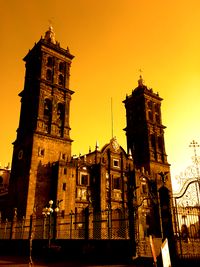
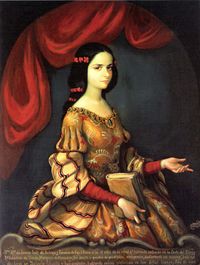
سادت الفوضى جميع أنحاء المستعمرة الإسپانية بعد أن احتلت القوات الفرنسيةلإسپانيا عام 1807، واعتقلت ملك لإسپانيا فرديناند السابع. وكان كوستيلا الكاهن من بين الذين خططوا للاستيلاء على مقاليد الحكم في المستعمرة، ففي 15 سبتمبر 1810 دعا الهنود وجماعات ذات أصول هندية إلى الكنيسة وألقى عليهم خطبة دعاهم من خلالها إلى التمرد على الإسپان.
وقد بدأ اتباع هيدالجو كوستيا بمهاجمة الشخصيات الرسمية الأسبانية وكل من كان يتعاون مع سلطات الحكم الإسپاني. إلا أن قوات كوستيلا أُجبرت على التراجع. وفي عام 1811، ألقت القوات الأسبانية القبض عليه وقتلته. وتمكنت القوات الأسبانية فيما بعد من القضاء على أتباع كوستيلا، وتم الإمساك بخليفته أيضًا وقتله سنة 1815.
وبحلول عام 1816، تمكن الجنود الإسپان من قتل جميع الثوار المكسيكيين، حيث ساد الهدوء والسلام جميع أنحاء المكسيك. وعاد الملك فرديناند السابع إلى أسبانيا. وهو يظن بأن جميع المكسيكيين يعارضون الحكم الأسباني، فنظّم جيشًا كبيرًا لقمع أية حركة تمرد في المكسيك. وفرض المزيد من الضرائب على السكان، وزادت أعماله من قناعة المكسيكيين بفقد الثقة بالأسبان.
الاستقلال عن إسپانيا (1821)

عندما ضعفت سلطة ملك أسبانيا فرديناند السابع، رأى معظم المكسيكيين أنها فرصة كبيرة لنجاح ثورتهم ضد الأسبان. واجتمع قائد الجيش الإسپاني مع قائد الثوار المكسيكي في 21 فبراير 1821م. وأعلنا استقلال المكسيك. وبحلول عام 1824 أصبحت المكسيك جمهورية ذات سيادة، لها رئيس، ومجلسا نواب وشيوخ يديران شؤون البلاد، ويدير الحكام شؤون الولايات، وأصبح گوادالوپ ڤكتوريا وهو أحد أتباع كوستيلا أول رئيس للبلاد.
ميلاد البلاد
الخسائر الاقليمية واصلاحات خواريز
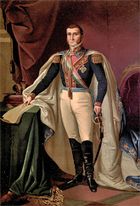
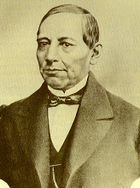
پورفيرياتو (1876–1910)
الثورة المكسيكية (1910–1920)

The Mexican Revolution was a decade-long transformational conflict.[121] It began with scattered uprisings against President Díaz after the fraudulent 1910 election, his resignation in May 1911, demobilization of rebel forces and an interim presidency of a member of the old guard, and the democratic election of a rich, civilian landowner, Francisco I. Madero in fall 1911. In February 1913, a military coup d'état overthrew Madero's government, with the support of the U.S., resulting in Madero's murder by agents of Federal Army General Victoriano Huerta. A coalition of anti-Huerta forces in the North, the Constitutional Army led by Governor of Coahuila Venustiano Carranza, and a peasant army in the South under Emiliano Zapata defeated the Federal Army.[93]
In 1914, that army was dissolved as an institution, leaving only revolutionary forces. Following the revolutionaries' victory against Huerta, they sought to broker a peaceful political solution, but the coalition splintered, plunging Mexico again into a civil war. Constitutionalist general Pancho Villa, commander of the Division of the North, broke with Carranza and allied with Zapata. Carranza's best general Alvaro Obregón defeated Villa, his former comrade-in-arms in the Battle of Celaya in 1915, and Villa's northern forces melted away. Zapata's forces in the south reverted to guerrilla warfare. Carranza became the de facto head of Mexico, and the U.S. recognized his government.[93]
In 1916, the winners met at a constitutional convention to draft the Constitution of 1917, which was ratified in February 1917. The Constitution empowered the government to expropriate resources including land, gave rights to labor, and strengthened anticlerical provisions of the 1857 Constitution.[93] With amendments, it remains the governing document of Mexico. It is estimated that the war killed 900,000 of the 1910 population of 15 million.[122][123] Although often viewed as an internal conflict, the revolution had significant international elements.[124] During the Revolution, the U.S. Republican administration of Taft supported the Huerta coup against Madero, but when Democrat Woodrow Wilson was inaugurated as president in March 1913, Wilson refused to recognize Huerta's regime and allowed arms sales to the Constitutionalists. Wilson ordered troops to occupy the strategic port of Veracruz in 1914, which was lifted.[125]

After Pancho Villa was defeated by revolutionary forces in 1915, he led an incursion raid into Columbus, New Mexico, prompting the U.S. to send 10,000 troops led by General John J. Pershing in an unsuccessful attempt to capture Villa. Carranza pushed back against U.S. troops being in northern Mexico. The expeditionary forces withdrew as the U.S. entered World War I.[126] Germany attempted to get Mexico to side with it, sending a coded telegram in 1917 to incite war between the U.S. and Mexico, with Mexico to regain the territory it lost in the Mexican-American War.[127] Mexico remained neutral in the conflict.
Consolidating power, President Carranza had peasant-leader Emiliano Zapata assassinated in 1919. Carranza had gained support of the peasantry during the Revolution, but once in power he did little to institute land reform, which had motivated many to fight in the Revolution. Carranza in fact returned some confiscated land to their original owners. President Carranza's best general, Obregón, served briefly in his administration, but returned to his home state of Sonora to position himself to run in the 1920 presidential election. Since Carranza could not run for re-election, he chose a civilian, political and revolutionary no-body to succeed him, intending to remain the power behind the presidency. Obregón and two other Sonoran revolutionary generals drew up the Plan of Agua Prieta, overthrowing Carranza, who died fleeing Mexico City in 1920. General Adolfo de la Huerta became interim president, followed by the election of General Álvaro Obregón.
حكم الحزب الواحد (1929–2000)

The first quarter-century of the post-revolutionary period (1920–1946) was characterized by revolutionary generals serving as Presidents of Mexico, including Álvaro Obregón (1920–24), Plutarco Elías Calles (1924–28), Lázaro Cárdenas (1934–40), and Manuel Avila Camacho (1940–46). The post-revolutionary project of the Mexican government sought to bring order to the country, end military intervention in politics, and create organizations of interest groups. Workers, peasants, urban office workers, and even the army for a short period were incorporated as sectors of the single party that dominated Mexican politics from its founding in 1929. Obregón instigated land reform and strengthened the power of organized labor. He gained recognition from the United States and took steps to settle claims with companies and individuals that lost property during the Revolution. He imposed his fellow former Sonoran revolutionary general, Calles, as his successor, prompting an unsuccessful military revolt. As president, Calles provoked a major conflict with the Catholic Church and Catholic guerrilla armies when he strictly enforced anticlerical articles of the 1917 Constitution. The Church-State conflict was mediated and ended with the aid of the U.S. Ambassador to Mexico and ended with an agreement between the parties in conflict. Although the constitution prohibited reelection of the president, Obregón wished to run again and the constitution was amended to allow non-consecutive re-election. Obregón won the 1928 elections, but was assassinated by a Catholic zealot, causing a political crisis of succession. Calles could not become president again, since he had just ended his term. He sought to set up a structure to manage presidential succession, founding the party that was to dominate Mexico until the late twentieth century. Calles declared that the Revolution had moved from caudillismo (rule by strongmen) to the era institucional (institutional era).[128]
Despite not holding the presidency, Calles remained the key political figure during the period known as the Maximato (1929–1934). The Maximato ended during the presidency of Lázaro Cárdenas, who expelled Calles from the country and implemented many economic and social reforms. This included the Mexican oil expropriation in March 1938, which nationalized the U.S. and Anglo-Dutch oil company known as the Mexican Eagle Petroleum Company. This movement would result in the creation of the state-owned Mexican oil company Pemex. This sparked a diplomatic crisis with the countries whose citizens had lost businesses by Cárdenas's radical measure, but since then the company has played an important role in the economic development of Mexico. Cárdenas's successor, Manuel Ávila Camacho (1940–1946) was more moderate, and relations between the U.S. and Mexico vastly improved during World War II, when Mexico was a significant ally, providing manpower and materiel to aid the war effort. From 1946 the election of Miguel Alemán, the first civilian president in the post-revolutionary period, Mexico embarked on an aggressive program of economic development, known as the Mexican miracle, which was characterized by industrialization, urbanization, and the increase of inequality in Mexico between urban and rural areas.[129]
With robust economic growth, Mexico sought to showcase it to the world by hosting the 1968 Summer Olympics. The government poured huge resources into building new facilities, prompting political unrest by university students and others. Demonstrations in central Mexico City went on for weeks before the planned opening of the games, with the government of Gustavo Díaz Ordaz cracking down. The culmination was the Tlatelolco Massacre,[102] which killed around 300 protesters based on conservative estimates and perhaps as many as 800.[130] Although the economy continued to flourish for some, social inequality remained a factor of discontent. PRI rule became increasingly authoritarian and at times oppressive in what is now referred to as the Mexican Dirty War.[131]
Luis Echeverría was elected president in 1970. His government had to contend with mistrust of Mexicans and increasing economic problems. He instituted electoral reforms.[132][106]
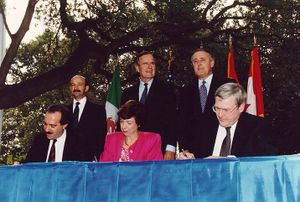
In the 1980s the first cracks emerged in the PRI's complete political dominance. In Baja California, the PAN candidate was elected as governor. When De la Madrid chose Carlos Salinas de Gortari as the candidate for the PRI, and therefore a foregone presidential victor, Cuauhtémoc Cárdenas, son of former President Lázaro Cárdenas, broke with the PRI and challenged Salinas in the 1988 elections. In 1988 there was massive electoral fraud, with results showing that Salinas had won the election by the narrowest percentage ever. There were massive protests in Mexico City to the stolen election. Salinas took the oath of office on 1 December 1988.[133] In 1990 the PRI was famously described by Mario Vargas Llosa as the "perfect dictatorship", but by then there had been major challenges to the PRI's hegemony.[134][135][136]
Salinas embarked on a program of neoliberal reforms that fixed the exchange rate of the peso, controlled inflation, opened Mexico to foreign investment, and began talks with the U.S. and Canada to join their free-trade agreement. In order to do that, the Constitution of 1917 was amended in several important ways. Article 27, which had allowed the government to expropriate natural resources and distribute land, was amended to end agrarian reform and to guarantee private owners' property rights. The anti-clerical articles that muzzled religious institutions, especially the Catholic Church, were amended and Mexico reestablished diplomatic relations with the Holy See. Signing on to the North American Free Trade Agreement (NAFTA) removed Mexico's autonomy over trade policy. The agreement came into effect on 1 January 1994; the same day, the Zapatista Army of National Liberation (EZLN) in Chiapas began armed peasant rebellion against the federal government, which captured a few towns, but brought world attention to the situation in Mexico. The armed conflict was short-lived and has continued as a non-violent opposition movement against neoliberalism and globalization. In 1994, following the assassination of the PRI's presidential candidate Luis Donaldo Colosio, Salinas was succeeded by victorious PRI candidate Ernesto Zedillo. Salinas left Zedillo's government to deal with the Mexican peso crisis, requiring a $50 billion IMF bailout. Major macroeconomic reforms were started by Zedillo, and the economy rapidly recovered and growth peaked at almost 7% by the end of 1999.[137]
نهاية حكم الحزب الواحد (2000–)
ازدادت المعارضة ضد الحزب الثوري الدستوري في الانتخابات العامة والمحلية منذ منتصف الثمانينيات. وفي عام 1988، انتخب مرشح الحزب كارلوس ساليناس دي غورتاري رئيسًا للمكسيك.
تعهد ساليناس برفع القيود الحكومية على الاقتصاد وإصلاح السياسة المكسيكية. وحاول إنعاش النمو الاقتصادي وحل مشكلة ديون المكسيك الأجنبية الضخمة من خلال زيادة تقليل ملكية الحكومة للأعمال التجارية وتشجيع قدر كبير من الاستثمارات الأجنبية في المكسيك. وفي ظل هذه الإصلاحات تحسن اقتصاد المكسيك.
وفي أبريل عام 1993، وافقت كل من المكسيك والولايات المتحدة وكندا على معاهدة التجارة الحرة لدول أمريكا الشمالية (نافتا) التي تقضي بإزالة الحواجز التجارية بين أعضائها. وبدأ العمل بهذه المعاهدة في يناير عام 1994. وفي يناير أيضًا اندلعت أعمال عنف في ولاية شيباس بين جنود الحكومة وأعضاء جيش التحرير الوطني الزباتستي بسبب الفقر الذي يعانيه سكان الإقليم. وبدأت محادثات السلام بينهما عندما تعهدت الحكومة بحل المشاكل الاقتصادية والسياسية. وفي أغسطس من نفس العام انتخب إرنيستو زيديلو بونس من الحزب الدستوري الثوري رئيسًا للمكسيك. وفي ديسمبر 1994، واجه زيديلو أزمة اقتصادية طاحنة هبط فيها البيزو إلى أرقام قياسية. وقد أدت المساعدات الدولية إلى تخفيف حدة الأزمة إلا أن اقتصاد المكسيك لا يزال يعاني من هذه الأزمة. وفي عام 1996، أجازت الحكومة المكسيكية قانوناً يعين بموجبه عمدة مدينة مكسيكو سيتي بالانتخاب وليس بوساطة الرئيس. وفي انتخابات عام 1997، فقد الحزب الدستوري الثوري معظم مقاعده في مجلس النواب.
التقسيمات الادارية
الولايات المتحدة المكسيكية هي عبارة عن اتحاد يضم واحدا وثلاثين ولاية حرة وذات سيادة، والتي تشكل اتحادا يمارس ولايته على المنطقة الاتحادية وغيرها من الأقاليم. لكل ولاية دستورها الخاص وكونغرس، فضلا عن السلطة القضائية، وينتخب مواطنوها من خلال التصويت المباشر، حاكم لمدة ست سنوات، فضلا عن ممثلين للبرلمان الذي يتكون من مجلس واحد، لمدة ثلاث سنوات.
والولايات أيضا مقسمة إلى بلديات، وهي أصغر كيان إداري سياسي في البلد، ويحكمها عمدة أو "رئيس بلدية"، الذي ينتخبه سكانها بطريقة الأغلبية. البلديات يمكن تقسيمها إلى مزيد من الأحياء غير المستقلة أو رئاسيات شبه مستقلة مساعدة.
دستوريًا، مكسيكو سيتي، كعاصمة ومقرا للسلطات الاتحادية، هي المقاطعة الاتحادية، وهي وحدة سياسية خاصة تنتمي إلى الاتحاد ككل وليس لولاية معينة، وعلى هذا النحو، لها حكم محلي أكثر محدودية من ولايات البلاد الأخرى.ومنذ عام 1987، اكتسبت تدريجيا درجة أكبر من الحكم الذاتي، والسكان الآن ينتخبون رئيس للحكومة وممثلين عن الجمعية التشريعية مباشرة. وعلى عكس الولايات، المقاطعة الاتحادية ليس لديها دستور ولكن النظام تشريع للحكومة. مكسيكو سيتي متطابقة مع المقاطعة الاتحادية.
 الولاية الفدرالية
الولاية الفدرالية أگواسكاليينتس
أگواسكاليينتس باها كاليفورنيا
باها كاليفورنيا باها كاليفورنيا سور
باها كاليفورنيا سور كامپيتشي
كامپيتشي تشياپاس
تشياپاس شيواوا
شيواوا كواويلا
كواويلا كوليما
كوليما دورانگو
دورانگو گواناخواتو
گواناخواتو گريرو
گريرو هيدالگو
هيدالگو خاليسكو
خاليسكو مكسيكو
مكسيكو ميتشواكان
ميتشواكان موريلوس
موريلوس ناياريت
ناياريت نويڤو ليون
نويڤو ليون واخاكا
واخاكا پويپلا
پويپلا كويريتارو
كويريتارو كوينتانا رو
كوينتانا رو سان لويز پوتوسي
سان لويز پوتوسي سينالوا
سينالوا سونورا
سونورا تاباسكو
تاباسكو تاماوليپاس
تاماوليپاس تلاسكالا
تلاسكالا ڤراكروز
ڤراكروز يوكاتان
يوكاتان زكاتكاس
زكاتكاس
الحكومة والسياسة
الحكومة
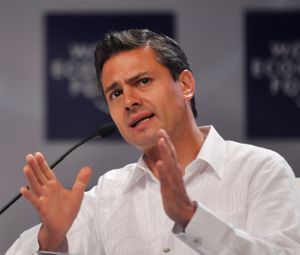
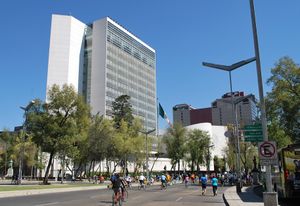
الولايات المتحدة المكسيكية هو اتحاد تعد حكومته تمثيلية، ديمقراطية وجمهورية مبنية على أساس نظام رئاسي وفقا لدستور عام 1917. وينص الدستور على ثلاثة مستويات من الحكومة : الاتحاد الفدرالي، وحكومات الولايات وحكومات البلديات. جميع المسؤولين على المستويات الثلاثة يتم انتخابهم من قبل الناخبين من خلال انتخاب فردي لا يشترط الأغلبية المطلقة، أو بتمثيل نسبي أو يتم تعيينهم من قبل غيرهم من المسؤولين المنتخبين.
الحكومة الاتحادية هي التي تتشكل من قوى الاتحاد، وهي فروع الحكومة الثلاثة المنفصلة :
السلطة التشريعية
وهو كونغرس الاتحاد المؤلف من مجلسين، وهما مجلس الشيوخ ومجلس النواب، الذان يشرعان القانون الاتحادي، ويعلنان الحرب، ويفرضان الضرائب، ويوافقان على الميزانية الوطنية والمعاهدات الدولية ويصادقان على التعيينات الدبلوماسية.
السلطة التنفيذية
رئيس الولايات المتحدة المكسيكية، الذي هو رئيس الدولة والحكومة، فضلا عن كونه القائد العام للقوات المسلحة للقوات العسكرية المكسيكية. كما يعين رئيس مجلس الوزراء ومسئولين آخرين. رئيس الجمهورية هو المسؤول عن تنفيذ وتطبيق القانون، وله سلطة الاعتراض على القوانين.
السلطة القضائية
محكمة العدل العليا، المؤلفة من أحد عشر قاضيا يعينهم رئيس الجمهورية مع موافقة مجلس الشيوخ، الذين يفسرون القوانين ويحكمون في قضايا الاختصاصات الاتحادية. المؤسسات الأخرى التابعة للقضاء هي المحكمة الانتخابية، والمحاكم الجماعية والوحدوية ومحاكم المقاطعات، ومجلس القضاء الاتحادي. جميع المسؤولين المنتخبين يتم انتخابهم بالأغلبية (بدون الحاجة إلى أغلبية مطلقة). مقاعد المجالس التشريعية الاتحادية والتشريعية تتم انتخابها عن طريق نظام التصويت الموازي الذي يتضمن نظامي الأغلبية والتمثيل النسبي.مجلس نواب الكونغرس الاتحادي يتكون من 300 نائبا يتم انتخابهم عن طريق الأغلبية و 200 نائبًا على أساس التمثيل النسبي بقوائم حزبية مغلقةبينما مجلس الشيوخ يتكون من ما مجموعه 128 من اعضاء مجلس الشيوخ : 64 من اعضاء مجلس الشيوخ، اثنان لكل ولاية، واثنان لمنطقة العاصمة الاتحادية، يتم انتخابهم مثنًا بالأغلبية ؛ و 32 من الاعضاء مخصصة للأقلية الأولى أو أول وصيف (واحد لكل ولاية وواحد لمنطقة العاصمة الاتحادية)، و 32 يتم تعيينهم على أساس التمثيل النسبي بالقوائم الحزبية المغلقة التي تعد البلاد فيها دائرة انتخابية واحدة.
وفقا للدستور، يجب على جميع الولايات المكونة للاتحاد أن يكون لديها شكل جمهوري للحكومة يتألف من ثلاثة فروع هي : السلطة التنفيذية، ويمثلها الحاكم ومجلس وزراء معين، والسلطة التشريعية يكونها كونغرس من مجلس واحد، والسلطة القضائية التي تشمل محكمة العدل العليا في الولاية. كما ان لها قوانينها المدنية والقضائية الخاصة بها.
كونگرس 2009-2012 الاتحادي تشكله سبعة احزاب؛ أربعة منها، بالرغم من ذلك، لم تفوز لا في هذه الانتخابات ولا في الانتخابات السابقة بأكثر من 4 ٪ من الأصوات الوطنية.بينما الأحزاب الثلاثة الأخرى كانت مهيمنة تاريخيا علي السياسة المكسيكيةحزب العمل الوطني : حزب يمين الوسط المحافظ الذي تأسس في عام 1939. حزب العمل قد حاز الأغلبية، ولكن ليس الأغلبية المطلقة في انتخابات برلمانية عدة. وفي عام 2000، حصل على الرئاسة لأول مرة. انه ينتمي إلى المنظمة الأمريكية الديمقراطية المسيحية.
تأسس عام 1929 لتوحيد جميع القوى وفصائل الثورة المكسيكية. أبرز الساسة اليساريين المكسيكيين كانوا أعضاء في هذا الحزب. ونظرًا لهيمنته على الساحة السياسية منذ الثورة المكسيكية، فإن الحزب الثوري المؤسسي يشمل فصائل مختلفة بما في ذلك بعض الاعضاء من اليمين الوسط.تأسس عام 1989 خلفا لائتلاف من الاشتراكيين والأحزاب الليبرالية، الجبهة الديمقراطية الوطنية التي مثلت ترشيح كواوتيموك كارديناس في انتخابات 1988 المثيرة للجدل.
منذ عام 1929 حافظ الحزب الثوري المؤسسي على السلطة في المكسيك بشكل يصل إلى الهيمنة. ومنذ عام 1977 تمت إصلاحات انتخابية متتالية سمحت لأحزاب المعارضة بكسب المزيد من المواقع على المستوى المحلي والاتحادي. هذه العملية بلغت ذروتها في الانتخابات الرئاسية عام 2000 التي أتت بفيسنتي فوكس مرشح حزب العمل الوطني، ليصبح أول رئيس ينتخب من خارج الحزب الثوري المؤسسي في 71 عاما.
وفي عام 2006، واجه فيليبي كالديرون من حزب العمل أندريس مانويل لوبيز اوبرادور من حزب الثورة الديموقراطية في انتخابات قريبة جدا (كان الفرق فيها 0.58 ٪)، عن طريق الأغلبية البسيطة - حيث أن النظام الانتخابي المكسيكي لا يشمل إعادة الانتخابات. لوبيز أوبرادور لم يقر نتائج الانتخابات، ولكن في 6 سبتمبر 2006، فيليب كالديرون أعلن الرئيس المنتخب من قبل المحكمة الانتخابية. وأدت حكومته اليمين الدستورية في منتصف الليل في 1 ديسمبر 2006، وسلم كالديرون سلمت الشارة الرئاسية من فيسنتي فوكس المنتهية ولايته في لوس بينوس. وأدى اليمين الدستورية رسميا كرئيس صباح يوم 1 ديسمبر 2006 في الكونگرس.
السياسة
إنفاذ القانون
الجريمة
العلاقات الخارجية
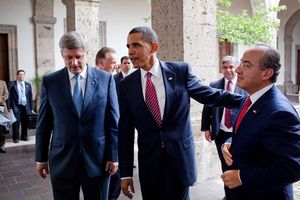
العسكرية

الجغرافيا

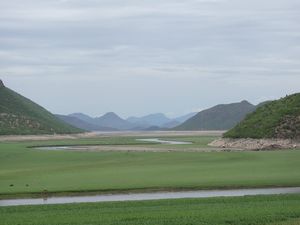
الموقع
تقريبا كل المكسيك تقع في صفيحة أمريكا الشمالية، باستثناء أجزاء صغيرة من شبه جزيرة منخفض كاليفورنيا التي تقع في صفيحتي المحيط الهادي وجزر كوكس. جيوفيزيائيًا، يضم بعض الجغرافيين إقليم شرق برزخ تيهوانتبيك (حوالي 12 ٪ من المجموع) إلي أمريكا الوسطى. ولكن من الناحية الجغرافية السياسية، فإن المكسيك تعتبر جزءا من أمريكا الشمالية بالكامل، إلى جانب كندا والولايات المتحدة.
المساحة
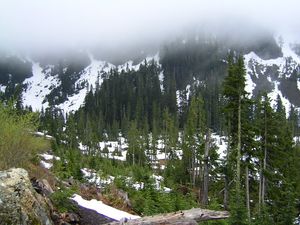
المكسيك مساحتها الإجمالية 1.972.550 كيلومتر مربع، مما يجعلها الدولة الرابعة عشر من حيث مجموع المساحة، وتضم ما يقرب من 6,000 كيلومتر مربع من الجزر في المحيط الهادي (بما في ذلك جزيرة گوادالوپه وجزر ريفيلاگيجيدو النائية) وخليج المكسيك وبحر الكاريبي، وخليج كاليفورنيا. وفي الشمال، المكسيك، تشترك مع الولايات المتحدة في حدود تبلغ 3،141 كيلومتر. تعرجات ريو برافو ديل نورت (المعروفة باسم ريو گرانده في الولايات المتحدة) تعرف الحدود من مدينة سيوداد خواريز شرقًا لخليج المكسيك. وسلسلة من العلامات الطبيعية والاصطناعية ترسم الحدود بين المكسيك والولايات المتحدة غرب سيوداد خواريز، إلى المحيط الهادئ. وفي الجنوب، المكسيك تشترك في 871 كيلومتر من الحدود مع گواتيمالا ولها حدود تبلغ 251 كيلومترا مع بليز.
الجبال
ثلثي مساحتها تغطيها سلاسل جبلية شاهقة، وهضاب متموجة، كما يوجد بها غابات مدارية وصحار جافة، وسهول أودية خصبة. فالمكسيك عبارة عن هضبة مرتفعة ضخمة تحيط بها السلاسل الجبلية التي تنحدر بشدة إلى سهول ساحلية ضيقة في الغرب والشرق، وتتلاقى سلسلتا جبال سيرا مادري الغربية وسيرا مادري الشرقية في منطقة تسمى لاجونت في الجنوب الشرقي حيث تكون السلسلتان سيرامادرا دلسور وهي مجموعة من الجبال البركانية المتداخلة تضم أعلى قمم المكسيك، وتؤدي سيرامادرادلسور إلى إيستموس في تيوانتيبك والتي تقع بين خليج كمبتشي وخليج تيوانتيبك، وتعتبر الهضبة الوسطى من أهم معالم الدولة الجغرافية والتي تعتبر امتداد لسهول الولايات المتحدة الجنوب غربية، وتشكل أكثر من نصف المساحة الإجمالية للمكسيك وتنحدر لأسفل من الغرب نحو الشرق ومن الشمال إلى الجنوب، وتضم الهضبة واديين واسعين يمثلان انخفاضا ملحوظا فيها وهما "بولسن دي مابيمو" في الشمال ووادي المكسيك أو انتوال في وسط المكسيك، أما السهول الساحلية فهي عموما منخفضة - مسطحة ورملية على الرغم من أن ساحل المحيط الهادي أحيانا ما تقطعه نتوءات جبلية، وتمتد شبه جزيرة كاليفورنيا التي تتميز بالطول والضيق لحوالي "760 ميل" جنوبا من الجزء الشمال غربي من الدولة وتقطعها بعض الجبال التي تعتبر امتدادا لسلسلة الجبال الساحلية في ولاية كاليفورنيا الأمريكية، وبالنسبة لشبه جزيرة يوكاتان والتي تشكل أعلى الجزء الجنوب شرقي من الدولة - منخفضة ومسطحة.
الأنهار
وتضم المكسيك عددا قليلا من الأنهار الرئيسية ومعظمها غير صالح للملاحة، ويعد نهر جراندي والذي يعرف في المكسيك أيضا باسم ريوبرافو ديل نورت من أطول الأنهار، ومن الأنهار الأخرى بالساس، جريجالفا، أوسوماسينتا، في الجنوب وكونشوس في الشمال. وتعتبر بحيرة "شابالا" في الغرب من أكبر مصادر المياه الداخلية، ويضم وادي المكسيك عددا من البحيرات الضحلة.
المناخ
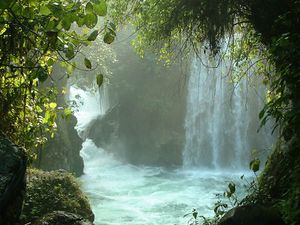

التنوع الحيوي


المكسيك هي واحدة من البلدان الثمانية عشر الشديدة التباين في العالم. بأكثر من 200،000 نوع مختلف، يستوطن المكسيك 10-12 ٪ من التنوع البيولوجي في العالم.المكسيك تحتل المرتبة الأولى في مجال التنوع البيولوجي في الزواحف حيث تحتوي على 707 مع الأنواع المعروفة، والمرتبة الثانية محتويةً على 438 نوعا من الثدييات، والرابعة في البرمائيات محتويةً على 290 من الأنواع، والرابعة في النباتات، محتويةً على 26،000 من الأنواع المختلفة.المكسيك أيضًا تعتبر ثاني دولة في العالم في النظام الإيكولوجي والرابعة في الأنواع عموما.وهناك حوالي 2،500 من الأنواع المحمية بموجب التشريعات المكسيكية.
ازالة الغابات
الحكومة المكسيكية أنشأت النظام الوطني للمعلومات عن التنوع البيولوجي، من أجل دراسة وترويج الاستعمال المستدام للنظم الإيكولوجية. إزالة الغابات هي واحدة من أخطر قضايا البيئة في المكسيك، حيث تفقد أكثر من مليون هكتار من الغابات كل سنة. اعتبارًا من عام 2002، كان للمكسيك ثاني أسرع معدل لإزالة الغابات في العالم، في المرتبة الثانية بعد البرازيل.
الطبيعة
في المكسيك، هناك 170،000 كيلومترا مربعا تعتبر "محميات طبيعية". وتشمل هذه المحميات 34 محيطات حيوية محفوظة (نظم إيكولوجية لم تتغير)، 64 متنزهًا وطنيًا، 4 معالم طبيعية (محمية إلى الأبد لقيمتها الجمالية أو العلمية أو التاريخية)، و 26 مناطق محمية من النباتات والحيوانات، و 4 مناطق لحماية الموارد الطبيعية (حفظ التربة، الأحواض المائية والغابات) و 17 ملاذات (مناطق غنية بالأنواع المختلفة).
الاقتصاد
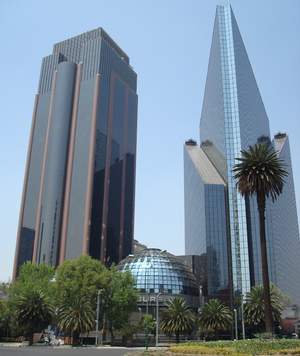

تُعد الصناعة والزراعة والتعدين والسياحة من أهم موارد الاقتصاد المكسيكي. ومن أبرز المنتجات الصناعية السيارات والاسمنت والمواد الكيميائية والملابس والمنتجات الغذائية والفولاذ. وتحتل المحاصيل الزراعية حوالي ثُمْن مساحة أراضي المكسيك، أما بقية الأراضي فإما أن تسودها ظروف جافة، أو أنها جبلية، أو غير صالحة للزراعة. ومع هذا، فإن المكسيك تُعد إحدى دول العالم الرئيسية المنتجة للبن والقطن والذرة الشامية والبرتقال وقصب السكر. المكسيك غنية بمواردها المعدنية، وهي من دول العالم الرئيسية في إنتاج الفضة. وفي المكسيك احتياطيات ضخمة من معادن النحاس والذهب والرصاص والملح والكبريت. أما إنتاج النفط، فقد كان مهما منذ زمن بعيد في المكسيك. وكان للاكتشافات الجديدة من النفط خلال السبعينيات من القرن العشرين الميلادي في المكسيك دور بارز في تعزيز أهمية صناعة النفط في البلاد.
أسست الحكومات المتعاقبة نظاماً تعليمياً وطنياً يتيح فرص التعليم للجميع، وأنشأت المستشفيات، ونفذت المشاريع الإسكانية. ومنذ الأربعينيات من القرن العشرين، أخذت الحكومة تشجع تطوير التعدين واستخراج النفط، ولكن هذه الإصلاحات الاقتصادية لم تجارِ النمو السكاني السريع؛ لذلك فالبلاد تواجه ظروفا اقتصادية صعبة، ومشاكل اجتماعية جمّة. ويعيش ما يزيد على ثلث سكان المكسيك في ظل الفقر. وتواصل الحكومة تنفيذ العديد من برامج المساعدات للفئات الفقيرة.
الزراعة
اكتشاف الأمريكتين جلب إلى بقية دول العالم العديد من المحاصيل الغذائية المستخدمة على نطاق واسع والنباتات الصالحة للأكل. بعض مكونات الطهي المكسيكية الأصلية تشمل : الشوكولاته، والطماطم، والذرة، والفانيليا والأفوكادو والجوافة والكمثرى الخضروية، الشاي المكسيكي، البطاطا الحلوة، حبة البطاطا، الصبار، الزعرور المكسيكي، تفحم الذرة، المشمش، العديد من أصناف الفول، ومجموعة متنوعة وأكبر من الفلفل الحار، مثل الفلفل الهافاني. معظم هذه الأسماء أتت من لغات السكان الأصليين كالناهواتل.
الاتصالات
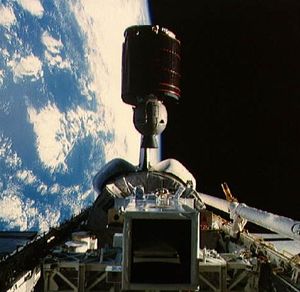
الطاقة

العلوم والتكنولوجيا في المكسيك
السياحة

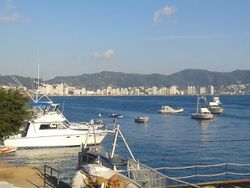
النقل
الديموغرافيا
| السنة | تعداد | ±% p.a. |
|---|---|---|
| 1895 | 12٬632٬427 | — |
| 1900 | 13٬607٬272 | +1.50% |
| 1910 | 15٬160٬369 | +1.09% |
| 1921 | 14٬334٬780 | −0.51% |
| 1930 | 16٬552٬722 | +1.61% |
| 1940 | 19٬653٬552 | +1.73% |
| 1950 | 25٬791٬017 | +2.75% |
| 1960 | 34٬923٬129 | +3.08% |
| 1970 | 48٬225٬238 | +3.28% |
| 1980 | 66٬846٬833 | +3.32% |
| 1990 | 81٬249٬645 | +1.97% |
| 1995 | 91٬158٬290 | +2.33% |
| 2000 | 97٬483٬412 | +1.35% |
| 2005 | 103٬263٬388 | +1.16% |
| 2010 | 112٬336٬538 | +1.70% |
| 2013 | 118٬395٬054 | +1.77% |
| المصدر: INEGI | ||
مستيزو
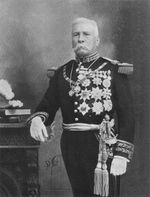
المكسيكيون من أصل أوروپي
انظر أيضاً: مكسيكيون بيض

الشعوب الأصلية
علم الوراثة السكاني
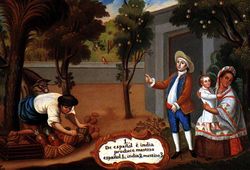
اللغات
الدين
المساواة النوعية
المناطق الكبرى
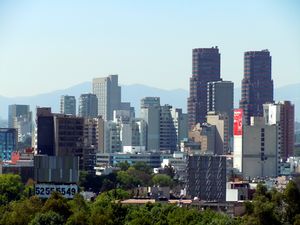
الثقافة
وقد برزت جهودهم في مجال العمارة الوطنية في مدينة مكسيكو وكذلك متحف الأنثروبولوجيا الوطني وعمارة البرج المؤلفة من 44 طابقاً في المدينة نفسها. تشمل أعمال الرسامين المكسيكيين رسوماتهم الجميلة على جدران العديد من المباني، وصور المسؤولين الرسميين. وأبرز معالم فن الرسم المكسيكي عُرفت جيدًا بعد قيام الثورة المكسيكية عام 1910م، ففي العشرينيات من القرن العشرين الميلادي سجّل كل من خوزيه أوروزكو ودييجو ريفيرا وديفيد سفيويروس قصة الثورة من خلال رسوماتهم الجميلة على جدران المباني العامة.
الأدب
من أهم كتاب المكسيك خلال القرن التاسع عشر الميلادي الكاتب المسرحي جوان ريز دي ألاركون والشاعر جوانا إينيس دي لاكروز والروائي خوزيه جاوكوين فرنانديز. وتجدد الأدب المكسيكي على يد كل من كارلوس فونتيس وجوان رولفو. وهناك أيضًا الشاعر أوكتاڤيو باز الذي نال [جائزة نوبل في الأدب]] عام 1992.
الفنون البصرية
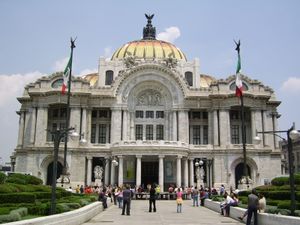
تُعد الفنون من أهم أنشطة الحياة المكسكية منذ أيام الهنود القدماء. بنت جماعات المايا والتولتيك الهندية المعابد، وزينت جدرانها بالرسوم والنقوش الجميلة، كما نظم بعض أفراد قبيلة الأزتك الشعر والموسيقى. وأضفى الأسبان المعمار على المباني التي شُيدت إبان حقبتهم. وقد أسهم الحرفيون الهنود في بناء آلاف الكنائس ذات النمط المعماري الأسباني وزخرفتها. وظهر في المكسيك العديد من أبرز المعماريين والرسامين والكتاب والمغنين وفي مجال العمارة قدم المعماريون المكسيكيون تصاميم حديثة.
السينما والإعلام
تحقق المسلسلات المكسيكية مبيعات لا مثيل لها في جميع دول العالم. قصص الحب والغرام الطويلة توزع على دول العالم وتدبلج إلى عدة لغات عالمية منها اللغة العربية، حيت تترجم عشرات المسلسلات المكسيكية من طرف شركات الدبلجة اللبنانية والأردنية والمغربية والسورية لتوزع لأقطار العالم العربي.
الموسيقى
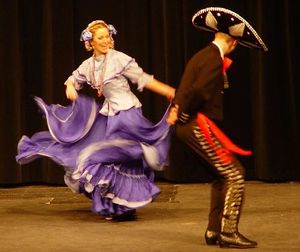
في الموسيقى استخدم الهنود القدماء الطبول والقِرب (آلات النفخ الموسيقية)، وغيرها من الآلات الموسيقية في حفلات الرقص والموسيقى. ولا تزال الموسيقى القديمة تُعزف في أجزاء مختلفة من المكسيك. ولا تزال الأغاني الشعبية كذلك هي المفضلة في جميع أنحاء البلاد. وتدور الأغاني حول الثورة المكسيكية. وتقيم الفرق الموسيقية المكسيكية الحفلات في المطاعم والساحات العامة، وتضم الفرقة المغنّين وعازفي القيثار والبوق والكمان.
المطبخ
الرياضة
الرعاية الصحية
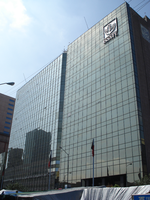
التعليم
انظر أيضاً
المصادر
- ^ "Global Religion - Religious Beliefs Across the World" (PDF). Ipsos. May 2023. Archived (PDF) from the original on 12 May 2023. Retrieved 23 August 2023.
- ^ "Political Constitution of the United Mexican States, title 2, article 40" (PDF). MX Q: SCJN. Archived from the original (PDF) on 11 May 2011. Retrieved 14 August 2010.
- ^ "Surface water and surface water change". Organisation for Economic Co-operation and Development (OECD). Archived from the original on 24 March 2021. Retrieved 11 October 2020.
- ^ قالب:Cite CIA World Factbook
- ^ أ ب ت ث "World Economic Outlook Database, October 2023 Edition. (Mexico)". IMF.org. International Monetary Fund. 10 October 2023. Archived from the original on 2 November 2023. Retrieved 10 October 2023.
- ^ Inequality - Income inequality - OECD Data. OECD. Archived from the original on 1 July 2022. Retrieved 12 August 2021.
- ^ "Human Development Report 2021-2022" (PDF) (in الإنجليزية). United Nations Development Programme. 15 December 2020. Archived (PDF) from the original on 9 October 2022. Retrieved 15 December 2020.
- ^ INALI (13 March 2003). "General Law of Linguistic Rights of the Indigenous Peoples" (PDF). Archived (PDF) from the original on 3 August 2016. Retrieved 7 November 2010.
- ^ "Catálogo de las lenguas indígenas nacionales: Variantes lingüísticas de México con sus autodenominaciones y referencias geoestadísticas". Inali.gob.mx. Archived from the original on 8 July 2014. Retrieved 18 July 2014.
- ^ Romo, Rafael (November 23, 2012). "After nearly 200 years, Mexico may make the name official". CNN.
- ^ "About Mexico". Embajada de Mexico en Estados Unidos (Mexican Embassy in the United States). 2012-12-03. Retrieved 2013-07-17.
- ^ "Official name of the country". Presidency of Mexico. March 31, 2005. Retrieved May 30, 2010.
- ^ أ ب Mexico entry at The World Factbook
- ^ Merriam-Webster's Geographical Dictionary, 3rd ed., Springfield, Massachusetts, USA, Merriam-Webster; p. 733
- ^ "INEGI 2010 Census Statistics". www.inegi.org.mx. Retrieved November 25, 2010.
- ^ James Scott; Matthias vom Hau; David Hulme. "Beyond the BICs: Strategies of influence". The University of Manchester. Retrieved April 11, 2012.
{{cite web}}: CS1 maint: multiple names: authors list (link) - ^ "How to compare regional powers: analytical concepts and research topics" (PDF). British International Studies Association. Retrieved April 11, 2012.[dead link]
- ^ "Ministry of Foreign Affairs of Japan" (PDF). Retrieved 2012-05-07.
- ^ "Oxford Analytica". Wayback.archive.org. Archived from the original on 2007-04-24. Retrieved 2013-07-17.
- ^ "Country and Lending Groups". World Bank. Retrieved March 5, 2011.
Uppermiddle Income defined as a per capita income between $3,976 – $12,275
- ^ Paweł Bożyk (2006). "Newly Industrialized Countries". Globalization and the Transformation of Foreign Economic Policy. Ashgate Publishing. p. 164. ISBN 0-7546-4638-6.
- ^ Mauro F. Guillén (2003). "Multinationals, Ideology, and Organized Labor". The Limits of Convergence. Princeton University Press. pp. 126 (table 5.1). ISBN 0-691-11633-4.
- ^ David Waugh (2000). "Manufacturing industries (chapter 19), World development (chapter 22)". Geography, An Integrated Approach (3rd ed.). Nelson Thornes. pp. 563, 576–579, 633, and 640. ISBN 0-17-444706-X.
- ^ N. Gregory Mankiw (2007). Principles of Economics (4th ed.). Mason, Ohio: Thomson/South-Western. ISBN 0-324-22472-9.
- ^ "G8: Despite Differences, Mexico Comfortable as Emerging Power". ipsnews.net. June 5, 2007. Retrieved May 30, 2010.
- ^ "Mexico (05/09)". US Department of State. 2012-06-25. Retrieved 2013-07-17.
- ^ "CRS Report for Congress" (PDF). Congressional Research Service. November 4, 2008. Retrieved 2013-07-17.
- ^ "UNESCO World Heritage Centre — World Heritage List". UNESCO. Retrieved May 25, 2012.
- ^ "Mexico's World Heritage Sites Photographic Exhibition at UN Headquarters". whc.unesco.org. Retrieved May 30, 2010.
- ^ Table of World Heritage Sites by country
- ^ "UNWTO Tourism Highlights: 2011 Edition" (PDF). World Tourism Organization. Archived from the original (PDF) on 2012-01-13. Retrieved May 18, 2013.
- ^ "Mexico 2050: The World´s Fifth Largest Economy". :. 2010-03-17. Retrieved 2013-07-12.
{{cite web}}: CS1 maint: extra punctuation (link) - ^ "World in 2050 - The BRICs and beyond: prospects, challenges and opportunities" (PDF). PwC Economics. Retrieved 2013-07-17.
- ^ Brading, D.A., The First America: The Spanish Monarchy, Creole Patriots, and the Liberal State. Cambridge: Cambridge University Press 1991. ISBN 052139130X
- ^ Ricard, Robert, The Spiritual Conquest of Mexico, Lesley Byrd Simpson, trans. Berkeley and Los Angeles: University of California Press 1966
- ^ Greenberg, Amy S. (2013). A wicked war : Polk, Clay, Lincoln, and the 1846 U.S. invasion of Mexico. New York. ISBN 978-0-307-47599-2. OCLC 818318029.
{{cite book}}: CS1 maint: location missing publisher (link) - ^ Garner, Paul. Porfirio Díaz. Routledge 2001.
- ^ Jones, Halbert. The War has brought Peace to Mexico: World War II and the Consolidation of the Post-Revolutionary State. Albuquerque: University of New Mexico Press 2014.
- ^ Pruitt, Sarah. "The Surprising Role Mexico Played in World War II". HISTORY (in الإنجليزية). Archived from the original on 18 October 2022. Retrieved 20 May 2022.
- ^ Paweł Bożyk (2006). "Newly Industrialized Countries". Globalization and the Transformation of Foreign Economic Policy. Ashgate Publishing. p. 164. ISBN 978-0-7546-4638-9. Archived from the original on 4 November 2023. Retrieved 23 July 2018.
- ^ James Scott; Matthias vom Hau; David Hulme. "Beyond the BICs: Strategies of influence". The University of Manchester. Archived from the original on 25 May 2017. Retrieved 11 April 2012.
- ^ Nolte, Detlef (October 2010). "How to compare regional powers: analytical concepts and research topics". Review of International Studies. 36 (4): 881–901. doi:10.1017/S026021051000135X. JSTOR 40961959. S2CID 13809794. ProQuest 873500719. Archived from the original on 2 March 2021. Retrieved 17 November 2020.
- ^ "Oxford Analytica". Archived from the original on 24 April 2007. Retrieved 17 July 2013.
- ^ "G8: Despite Differences, Mexico Comfortable as Emerging Power". ipsnews.net. 5 June 2007. Archived from the original on 16 August 2008. Retrieved 30 May 2010.
- ^ Mauro F. Guillén (2003). "Multinationals, Ideology, and Organized Labor". The Limits of Convergence. Princeton University Press. p. 126 (table 5.1). ISBN 978-0-691-11633-4.
- ^ David Waugh (2000). "Manufacturing industries (chapter 19), World development (chapter 22)". Geography, An Integrated Approach (3rd ed.). Nelson Thornes. pp. 563, 576–579, 633, and 640. ISBN 978-0-17-444706-1. Archived from the original on 4 February 2024. Retrieved 23 July 2018.
- ^ N. Gregory Mankiw (2007). Principles of Economics (4th ed.). Mason, Ohio: Thomson/South-Western. ISBN 978-0-324-22472-6. Archived from the original on 4 February 2024. Retrieved 23 July 2018.
- ^ [1] Archived 4 فبراير 2024 at the Wayback Machine UNESCO World Heritage sites, accessed 9 May 2022
- ^ "What is a mega-diverse country?". Mexican biodiversity. Archived from the original on 7 September 2019. Retrieved 13 July 2019.
- ^ "México ocupa el sexto lugar en turismo a nivel mundial". www.expansion.mx. CNN Expansión. 28 August 2018. Archived from the original on 23 December 2019. Retrieved 8 January 2019.
- ^ "Global Peace Index 2019: Measuring Peace in a Complex World" (PDF). Vision of Humanity. Sydney: Institute for Economics & Peace. June 2019. Archived from the original (PDF) on 27 August 2019. Retrieved 4 June 2020.
- ^ خطأ استشهاد: وسم
<ref>غير صحيح؛ لا نص تم توفيره للمراجع المسماةcfrdeaths - ^ Werner 2001, pp. 386–.
- ^ Susan Toby Evans; David L. Webster (2013). Archaeology of Ancient Mexico and Central America: An Encyclopedia. Routledge. p. 54. ISBN 978-1-136-80186-0.
- ^ Colin M. MacLachlan (13 April 2015). Imperialism and the Origins of Mexican Culture. Harvard University Press. p. 39. ISBN 978-0-674-28643-6.
- ^ Carmack, Robert M.; Gasco, Janine L.; Gossen, Gary H. (2016). The Legacy of Mesoamerica: History and Culture of a Native American Civilization. Routledge. ISBN 978-1-317-34678-4.[صفحة مطلوبة]
- ^ Diehl, Richard A. (2004). The Olmecs: America's First Civilization. Thames & Hudson. pp. 9–25. ISBN 978-0-500-02119-4.
- ^ Restall, Matthew, "A History of the New Philology and the New Philology in History", Latin American Research Review - Volume 38, Number 1, 2003, pp.113–134
- ^ Sampson, Geoffrey (1985). Writing Systems: A Linguistic Introduction. Stanford University Press. ISBN 978-0-8047-1756-4.[صفحة مطلوبة]
- ^ Cowgill, George L. (21 October 1997). "State and Society at Teotihuacan, Mexico". Annual Review of Anthropology. 26 (1): 129–161. doi:10.1146/annurev.anthro.26.1.129. OCLC 202300854. S2CID 53663189.
- ^ "Ancient Civilizations of Mexico". Ancient Civilizations World. 12 January 2017. Archived from the original on 12 July 2019. Retrieved 14 July 2019.
- ^ "The word "Azteca" was NOT created by Von Humboldt!". Mexicka.org. 31 May 2014. Archived from the original on 25 March 2019. Retrieved 13 July 2019.
- ^ León Portilla, Miguel (10 May 2009). "Los aztecas, disquisiciones sobre un gentilico". Estudios de Cultura Náhuatl. 31 (31). Archived from the original on 21 December 2020. Retrieved 17 November 2020.
- ^ Lockhart, James and Stuart B. Schwartz. Early Latin America. Cambridge: Cambridge University Press 1983, 59
- ^ Chuchiak, John F. IV, "Inquisition" in Encyclopedia of Mexico. Chicago: Fitzroy Dearborn 1997, pp. 704–708
- ^ Schmal, John P. (17 July 2003). "The Indigenous People of Zacatecas". Latino LA: Comunidad. Archived from the original on 14 March 2016. Retrieved 14 July 2019.
- ^ Charlotte M. Gradie (2000). "The Tepehuan Revolt of 1616: Militarism, Evangelism, and Colonialism in Seventeenth-Century Nueva Vizcaya". The Americas. Salt Lake City: University of Utah Press. 58 (2): 302–303. doi:10.1353/tam.2001.0109. S2CID 144896113.
- ^ Wasserstrom, Robert (1980). "Ethnic Violence and Indigenous Protest: The Tzeltal (Maya) Rebellion of 1712". Journal of Latin American Studies. 12: 1–19. doi:10.1017/S0022216X00017533. S2CID 145718069.
- ^ Taylor, William B. (1 June 1979). Drinking, Homicide, and Rebellion in Colonial Mexican Villages (1st ed.). Stanford: Stanford University Press. ISBN 978-0804711128.
- ^ White, Benjamin (31 January 2017). "Campeche, Mexico – largest pirate attack in history, now UNESCO listed". In Search of Lost Places. Archived from the original on 15 July 2019. Retrieved 14 July 2019.
- ^ Knispel, Sandra (13 December 2017). "The mysterious aftermath of an infamous pirate raid". University of Rochester Newsletter. Archived from the original on 15 July 2019. Retrieved 14 July 2019.
- ^ Cope, R. Douglas. The Limits of Racial Domination: Plebeian Society in Colonial Mexico City, 1660–1720. Madison, Wis.: U of Wisconsin, 1994.
- ^ Altman, et al. The Early History of Greater Mexico, 342–43
- ^ "Grito de Dolores". Encyclopaedia Britannica. Archived from the original on 11 September 2018. Retrieved 12 September 2018.
- ^ Van Young, Stormy Passage, 179–226
- ^ Benson, Nettie Lee. "The Plan of Casa Mata." Hispanic American Historical Review 25 (February 1945): 45–56.
- ^ Hale, Charles A. Mexican Liberalism in the Age of Mora. New Haven: Yale University Press 1968. p. 224
- ^ "Ways of ending slavery". Encyclopædia Britannica. Archived from the original on 16 October 2014. Retrieved 23 June 2022.
- ^ Costeloe, Michael P. "Pastry War" in Encyclopedia of Latin American History and Culture, vol. 4, p. 318.
- ^ Van Young, Stormy Passage, "The Age of Santa Anna", 227–270
- ^ Weber, David J., The Mexican Frontier, 1821–1846: The American Southwest under Mexico, University of New Mexico Press, 1982
- ^ Angel Miranda Basurto (2002). La Evolucíon de Mėxico [The Evolution of Mexico] (in الإسبانية) (6th ed.). Mexico City: Editorial Porrúa. p. 358. ISBN 970-07-3678-4.
- ^ Britton, John A. "Liberalism" in Encyclopedia of Mexico739
- ^ Hamnett, Brian. "Benito Juárez" in Encyclopedia of Mexico, pp. 719–20
- ^ Britton, "Liberalism" p. 740.
- ^ Sullivan, Paul. "Sebastián Lerdo de Tejada" in Encyclopedia of Mexico. pp. 736–38
- ^ Adela M. Olvera (2 February 2018). "El Porfiriato en Mexico" [The Porfiriato in Mexico]. Inside Mexico.com (in الإسبانية). Archived from the original on 26 March 2019. Retrieved 18 July 2019.
- ^ Buchenau, Jürgen. "Científicos". Encyclopedia of Mexico, pp. 260–265
- ^ Schmidt, Arthur, "José Ives Limantour" in Encyclopedia of Mexico, pp. 746–49.
- ^ "cientifico". Encyclopædia Britannica (in الإنجليزية). Archived from the original on 7 February 2017. Retrieved 7 February 2017.
- ^ Brenner, Anita (1 January 1984). The Wind that Swept Mexico: The History of the Mexican Revolution of 1910–1942 (New ed.). University of Texas Press. ISBN 978-0292790247.
- ^ Benjamin, Thomas. La Revolución: Mexico's Great Revolution as Memory, Myth, and History. Austin: University of Texas Press 2000
- ^ أ ب ت ث ج ح Matute, Alvaro. "Mexican Revolution: May 1917 – December 1920" in Encyclopedia of Mexico, 862–864.
- ^ "The Mexican Revolution". Public Broadcasting Service. 20 November 1910. Archived from the original on 14 May 2011. Retrieved 17 July 2013.
- ^ Robert McCaa. "Missing millions: the human cost of the Mexican Revolution". University of Minnesota Population Center. Archived from the original on 2 April 2016. Retrieved 17 July 2013.
- ^ Katz, Friedrich. The Secret War in Mexico. Chicago: University of Chicago Press.
- ^ "The Mexican Revolution and the United States in the Collections of the Library of Congress, U.S. Involvement Before 1913". Library of Congress. Archived from the original on 19 July 2019. Retrieved 18 July 2019.
- ^ "Punitive Expedition in Mexico, 1916–1917". U.S. Department of State archive. 20 January 2009. Archived from the original on 15 June 2023. Retrieved 18 July 2019.
- ^ "ZIMMERMANN TELEGRAM". The National WWI Museum and Memorial. 2 March 2017. Archived from the original on 19 July 2019. Retrieved 18 July 2019.
- ^ Rafael Hernández Ángeles. "85º ANIVERSARIO DE LA FUNDACIÓN DEL PARTIDO NACIONAL REVOLUCIONARIO (PNR)" [85th anniversary of the founding of the National Revolutionary Party (PRN)]. Instituto Nacional de Estudios Historicos de las Revoluciones de Mexico (in الإسبانية). Archived from the original on 19 July 2019. Retrieved 18 July 2019.
- ^ "The Mexican Miracle: 1940–1968". World History from 1500. Emayzine. Archived from the original on 3 April 2007. Retrieved 30 September 2007.
- ^ أ ب Elena Poniatowska (1975). Massacre in Mexico. Viking, New York. ISBN 978-0-8262-0817-0. Archived from the original on 4 February 2024. Retrieved 23 July 2018.
- ^ Kennedy, Duncan (19 July 2008). "Mexico's long forgotten dirty war". BBC News. Archived from the original on 29 June 2017. Retrieved 17 July 2013.
- ^ Krauze, Enrique (January–February 2006). "Furthering Democracy in Mexico". Foreign Affairs. Archived from the original on 10 January 2006. Retrieved 7 October 2007.
{{cite magazine}}: Cite magazine requires|magazine=(help) - ^ Schedler, Andreas (2006). Electoral Authoritarianism: The Dynamics of Unfree Competition. L. Rienner Publishers. ISBN 978-1-58826-440-4. Archived from the original on 4 February 2024. Retrieved 23 July 2018.
- ^ أ ب Crandall, R.; Paz and Roett (2004). "Mexico's Domestic Economy: Policy Options and Choices". Mexico's Democracy at Work. Lynne Reinner Publishers. p. 160. ISBN 978-0-8018-5655-6.
- ^ ""Mexico The 1988 Elections" (Sources: The Library of the Congress Country Studies, CIA World Factbook)". Photius Coutsoukis. Archived from the original on 15 September 2018. Retrieved 30 May 2010.
- ^ Gomez Romero, Luis (5 October 2018). "Massacres, disappearances and 1968: Mexicans remember the victims of a 'perfect dictatorship'". The Conversation. Archived from the original on 12 May 2019. Retrieved 12 May 2019.
- ^ "Vargas Llosa: "México es la dictadura perfecta"". El País. 1 September 1990. Archived from the original on 24 October 2011. Retrieved 12 May 2019.
- ^ Reding, Andrew (1991). "Mexico: The Crumbling of the "Perfect Dictatorship"". World Policy Journal. 8 (2): 255–284. JSTOR 40209208.
- ^ Cruz Vasconcelos, Gerardo. "Desempeño Histórico 1914–2004" (PDF) (in الإسبانية). Archived from the original (PDF) on 3 July 2006. Retrieved 17 February 2007.
- ^ Valles Ruiz, Rosa María (June 2016). "Elecciones presidenciales 2006 en México. La perspectiva de la prensa escrita" [2006 presidential Elections in Mexico. The Perspective of the Press]. Revista mexicana de opinión pública (in الإسبانية) (20): 31–51. Archived from the original on 21 March 2020. Retrieved 12 July 2019.
- ^ Reséndiz, Francisco (2006). "Rinde AMLO protesta como "presidente legítimo"". El Universal (in الإسبانية). Archived from the original on 18 January 2012. Retrieved 1 October 2007.
- ^ "Enrique Pena Nieto wins Mexican presidential election". The Telegraph. 2 July 2012. Archived from the original on 10 January 2022. Retrieved 25 August 2015.
- ^ Sieff, Kevin. "López Obrador, winner of Mexican election, given broad mandate". Washington Post. Archived from the original on 2 July 2018. Retrieved 2 July 2018.
- ^ Sharma, Gaurav (10 May 2018). "Mexico's Oil And Gas Industry Privatization Efforts Nearing Critical Phase". Forbes. Archived from the original on 4 June 2020. Retrieved 4 June 2020.
- ^ Barrera Diaz, Cyntia; Villamil, Justin; Still, Amy (14 February 2020). "Pemex Ex-CEO Arrest Puts AMLO in Delicate Situation". Rigzone. Bloomberg. Archived from the original on 27 May 2020. Retrieved 4 June 2020.
- ^ "Mexico's presidential front runner on high alert for election fraud ahead of Sunday's vote". South China Morning Post. Associated Press. 30 June 2018. Archived from the original on 23 May 2020. Retrieved 4 June 2020.
- ^ "Mexico's 2018 Elections: Results and Potential Implications" (PDF). fas.org. 17 July 2018. Archived (PDF) from the original on 4 February 2024. Retrieved 12 April 2021.
- ^ "Mexico's López Obrador sworn in as first leftist president in decades". BBC News. 2 December 2018. Archived from the original on 14 April 2021. Retrieved 7 April 2021.
- ^ Benjamin, Thomas. La Revolución: Mexico's Great Revolution as Memory, Myth, and History. Austin: University of Texas Press 2000
- ^ "The Mexican Revolution". Public Broadcasting Service. 20 November 1910. Archived from the original on 14 May 2011. Retrieved 17 July 2013.
- ^ Robert McCaa. "Missing millions: the human cost of the Mexican Revolution". University of Minnesota Population Center. Archived from the original on 2 April 2016. Retrieved 17 July 2013.
- ^ Katz, Friedrich. The Secret War in Mexico. Chicago: University of Chicago Press.
- ^ "The Mexican Revolution and the United States in the Collections of the Library of Congress, U.S. Involvement Before 1913". Library of Congress. Archived from the original on 19 July 2019. Retrieved 18 July 2019.
- ^ "Punitive Expedition in Mexico, 1916–1917". U.S. Department of State archive. 20 January 2009. Archived from the original on 15 June 2023. Retrieved 18 July 2019.
- ^ "ZIMMERMANN TELEGRAM". The National WWI Museum and Memorial. 2 March 2017. Archived from the original on 19 July 2019. Retrieved 18 July 2019.
- ^ Rafael Hernández Ángeles. "85º ANIVERSARIO DE LA FUNDACIÓN DEL PARTIDO NACIONAL REVOLUCIONARIO (PNR)" [85th anniversary of the founding of the National Revolutionary Party (PRN)]. Instituto Nacional de Estudios Historicos de las Revoluciones de Mexico (in الإسبانية). Archived from the original on 19 July 2019. Retrieved 18 July 2019.
- ^ "The Mexican Miracle: 1940–1968". World History from 1500. Emayzine. Archived from the original on 3 April 2007. Retrieved 30 September 2007.
- ^ Kennedy, Duncan (19 July 2008). "Mexico's long forgotten dirty war". BBC News. Archived from the original on 29 June 2017. Retrieved 17 July 2013.
- ^ Krauze, Enrique (January–February 2006). "Furthering Democracy in Mexico". Foreign Affairs. Archived from the original on 10 January 2006. Retrieved 7 October 2007.
{{cite magazine}}: Cite magazine requires|magazine=(help) - ^ Schedler, Andreas (2006). Electoral Authoritarianism: The Dynamics of Unfree Competition. L. Rienner Publishers. ISBN 978-1-58826-440-4. Archived from the original on 4 February 2024. Retrieved 23 July 2018.
- ^ ""Mexico The 1988 Elections" (Sources: The Library of the Congress Country Studies, CIA World Factbook)". Photius Coutsoukis. Archived from the original on 15 September 2018. Retrieved 30 May 2010.
- ^ Gomez Romero, Luis (5 October 2018). "Massacres, disappearances and 1968: Mexicans remember the victims of a 'perfect dictatorship'". The Conversation. Archived from the original on 12 May 2019. Retrieved 12 May 2019.
- ^ "Vargas Llosa: "México es la dictadura perfecta"". El País. 1 September 1990. Archived from the original on 24 October 2011. Retrieved 12 May 2019.
- ^ Reding, Andrew (1991). "Mexico: The Crumbling of the "Perfect Dictatorship"". World Policy Journal. 8 (2): 255–284. JSTOR 40209208.
- ^ Cruz Vasconcelos, Gerardo. "Desempeño Histórico 1914–2004" (PDF) (in الإسبانية). Archived from the original (PDF) on 3 July 2006. Retrieved 17 February 2007.
- ^ "Encyclopedia Britannica: Mexico Ethnic groups".
- ^ خطأ استشهاد: وسم
<ref>غير صحيح؛ لا نص تم توفيره للمراجع المسماة2010-census
المراجع
- Camp, Roderic A. Politics in Mexico: Democratic Consolidation Or Decline? (Oxford University Press, 2014)
- Davis, Diane. Urban leviathan: Mexico City in the twentieth century (Temple University Press, 2010)
- Domínguez, Jorge I. "The Scholarly Study of Mexican Politics," Mexican Studies / Estudios Mexicanos (2004) 20#2 pp 377–410.
- Edmonds-Poli, Emily, and David Shirk. Contemporary Mexican Politics (Rowman and Littlefield 2009)
- Kirkwood, Burton. The History of Mexico (Greenwood, 2000) online edition
- Krauze, Enrique (1998). Mexico: Biography of Power: A history of Modern Mexico 1810–1996. New York: Harper Perennial. p. 896. ISBN 0-06-092917-0.
- Meyer, Michael C.; Beezley, William H., eds. (2000). The Oxford History of Mexico. Oxford University Press. p. 736. ISBN 0-19-511228-8.
- Levy, Santiago. Good intentions, bad outcomes: Social policy, informality, and economic growth in Mexico (Brookings Institution Press, 2010)
- Meyer, Michael C., William L. Sherman, and Susan M. Deeds. The Course of Mexican History (7th ed. Oxford U.P., 2002) online edition
- Russell, Philip (2010). The history of Mexico: from pre-conquest to present. Routledge. ISBN 978-0-415-87237-9. Retrieved 2010-07-09.
- Tannenbaum, Frank. Mexico: the struggle for peace and bread (2013)
- Werner, Michael S. ed. Encyclopedia of Mexico: History, Society & Culture (2 vol 1997) 1440pp online edition
- Werner, Michael S. ed. Concise Encyclopedia of Mexico (2001) 850pp; a selection of unrevised articles
وصلات خارجية
- The Presidency of Mexico (إنگليزية)
- Mexico Tourism Official Website | VisitMexico
- Mexico entry at The World Factbook
- Mexico from UCB Libraries GovPubs
- المكسيك at the Open Directory Project
- Mexico from the BBC News
- Mexico at Encyclopædia Britannica
 Wikimedia Atlas of Mexico
Wikimedia Atlas of Mexico المكسيك travel guide from Wikivoyage
المكسيك travel guide from Wikivoyage- Key Development Forecasts for Mexico from International Futures
- Articles with dead external links from April 2014
- CS1 maint: location missing publisher
- مقالات بالمعرفة بحاجة لذكر رقم الصفحة بالمصدر from December 2020
- CS1 الإسبانية-language sources (es)
- CS1: Julian–Gregorian uncertainty
- Short description is different from Wikidata
- Articles containing إسپانية-language text
- Pages using gadget WikiMiniAtlas
- Pages using infobox country or infobox former country with the symbol caption or type parameters
- Ill-formatted IPAc-en transclusions
- Pages including recorded pronunciations
- Pages using Lang-xx templates
- Pages with plain IPA
- Articles with hatnote templates targeting a nonexistent page
- Pages using div col with unknown parameters
- Pages with empty portal template
- Pages using country topics with unknown parameters
- المكسيك
- جمهوريات دستورية اتحادية
- مستعمرات إسپانية سابقة
- بلدان مجموعة 15
- ديمقراطيات ليبرالية
- الدول الأعضاء في الأمم المتحدة
- بلدان ومناطق رومانسية
- دول ومناطق تأسست في 1813


